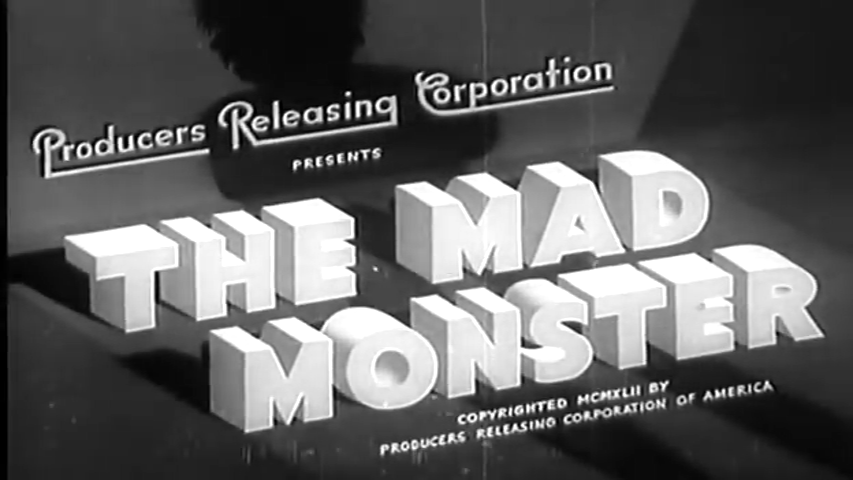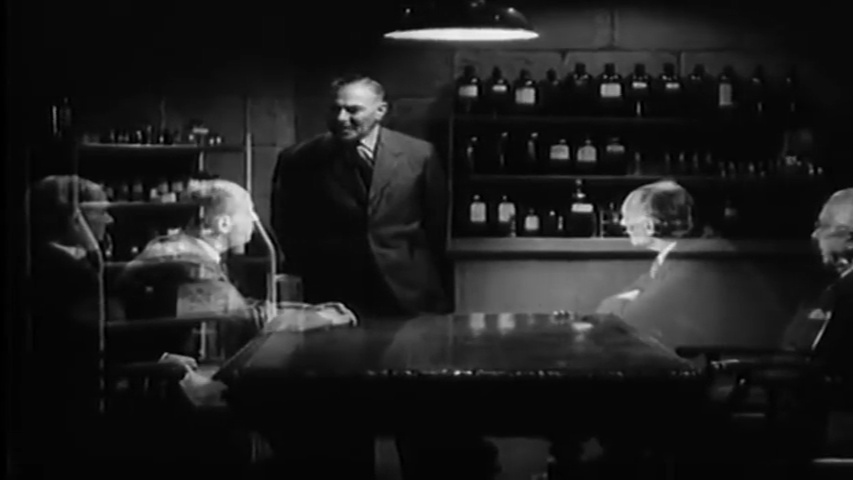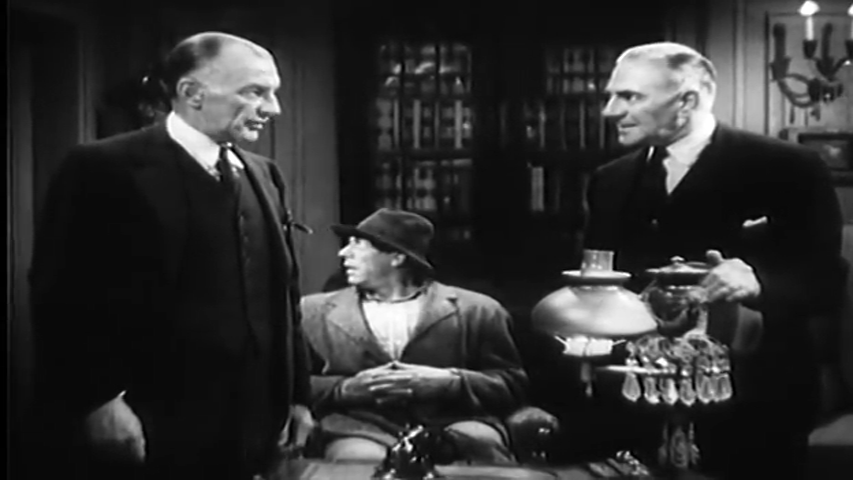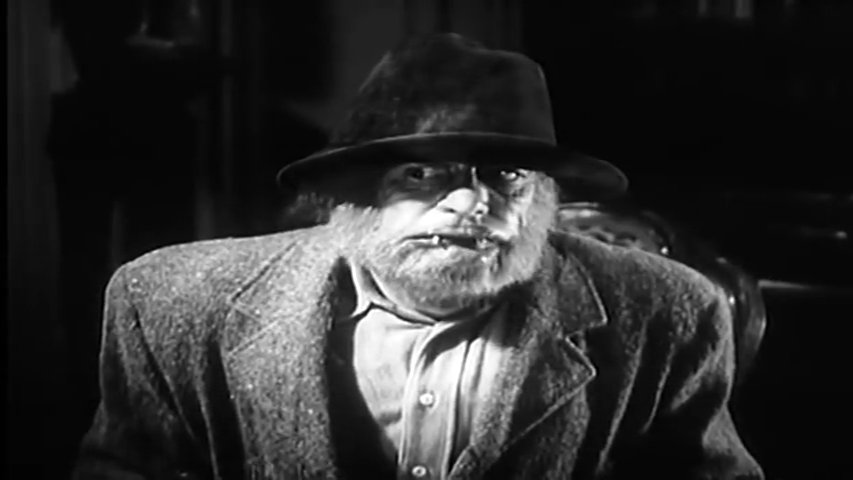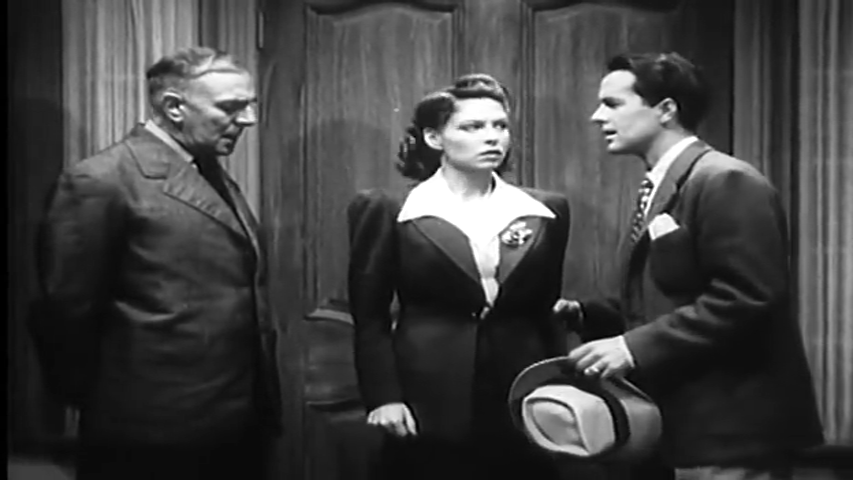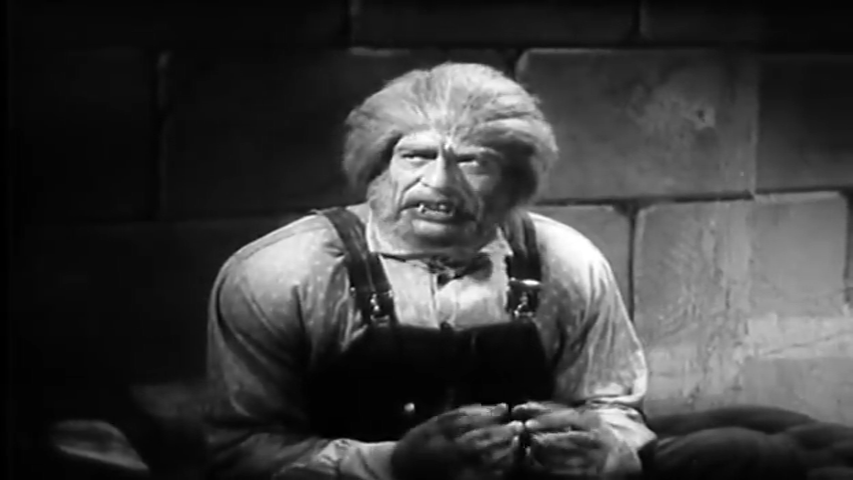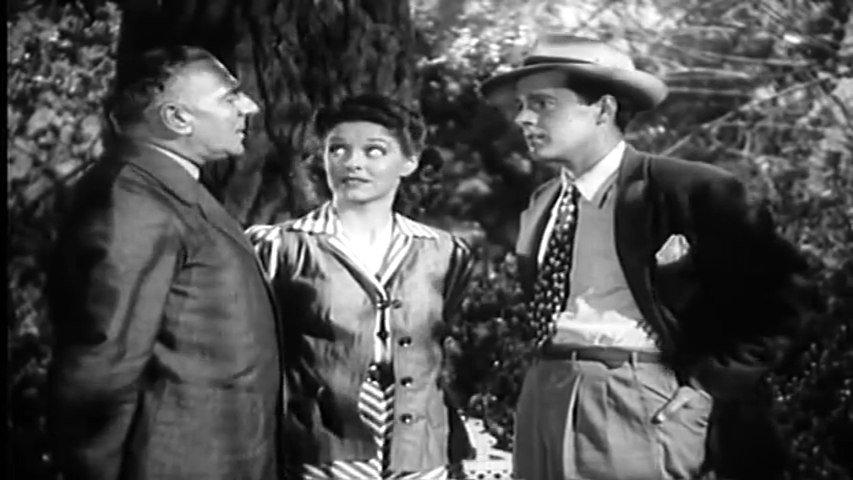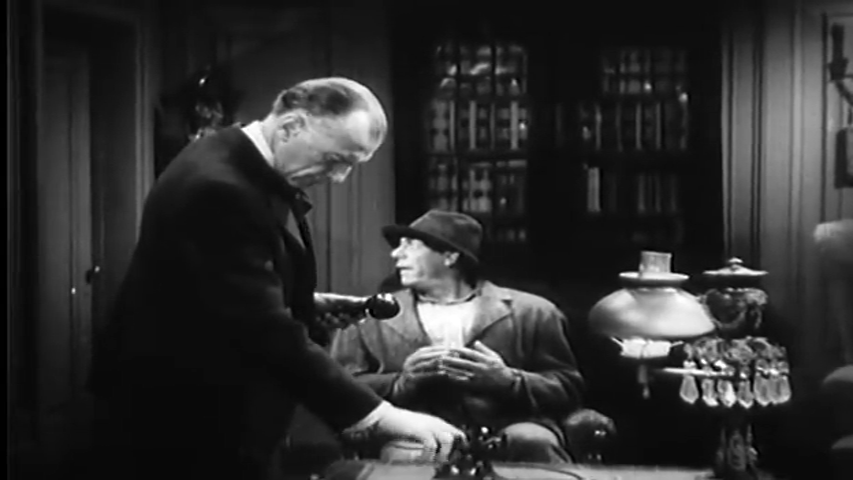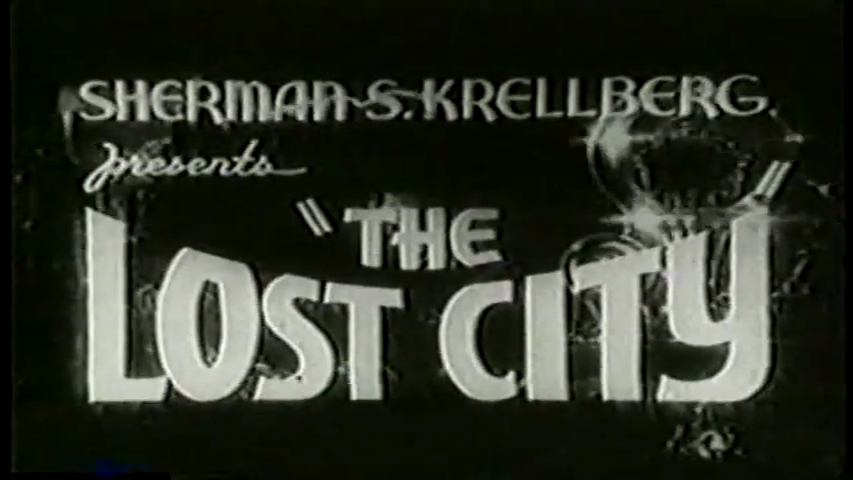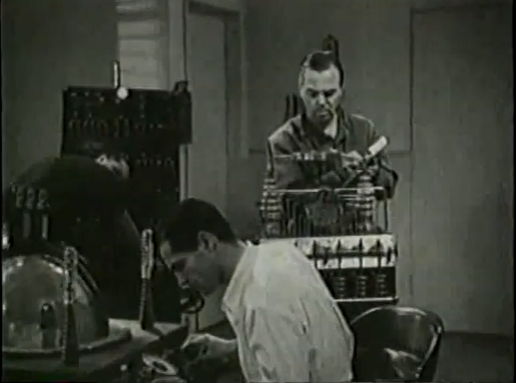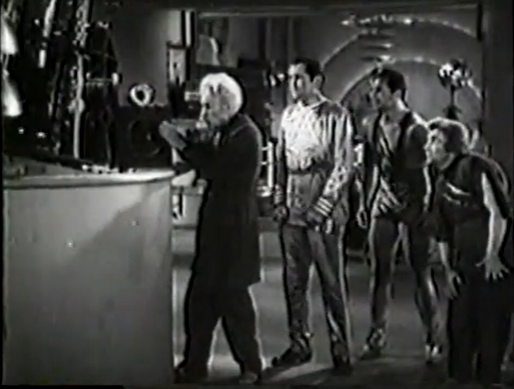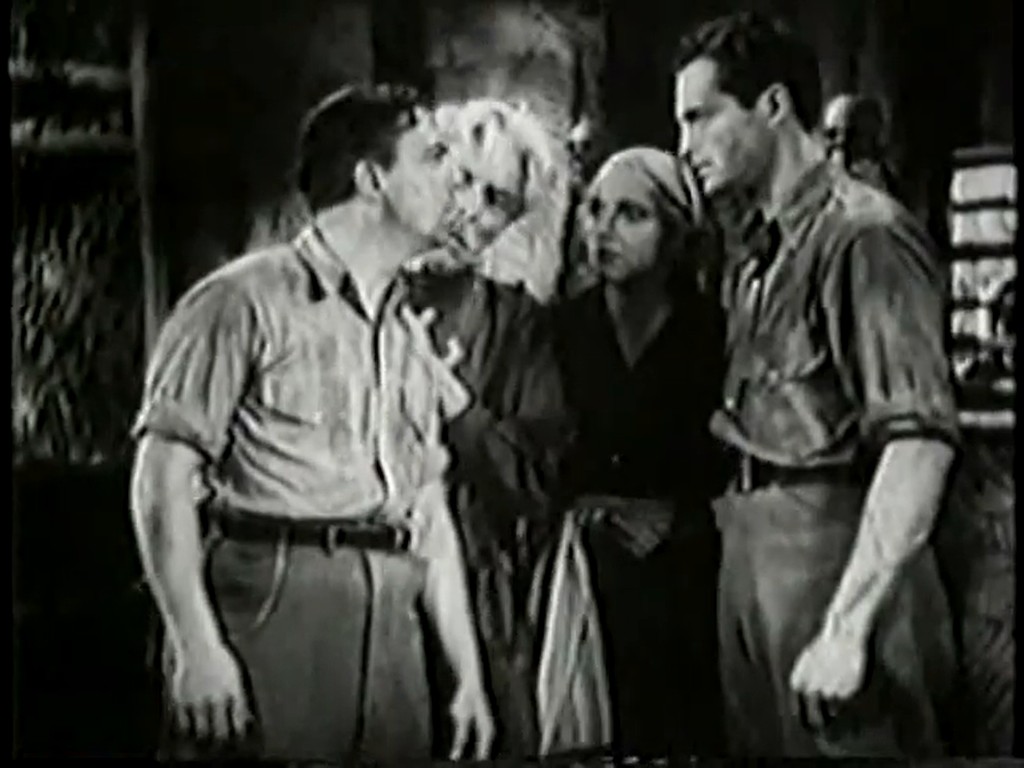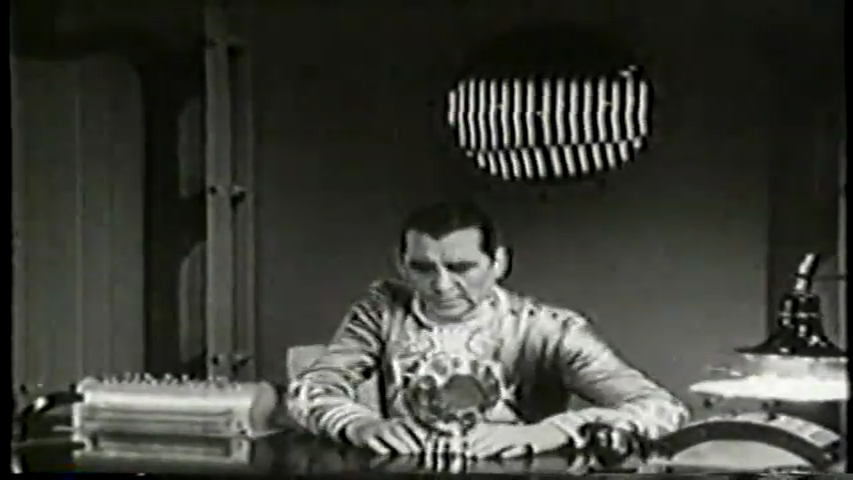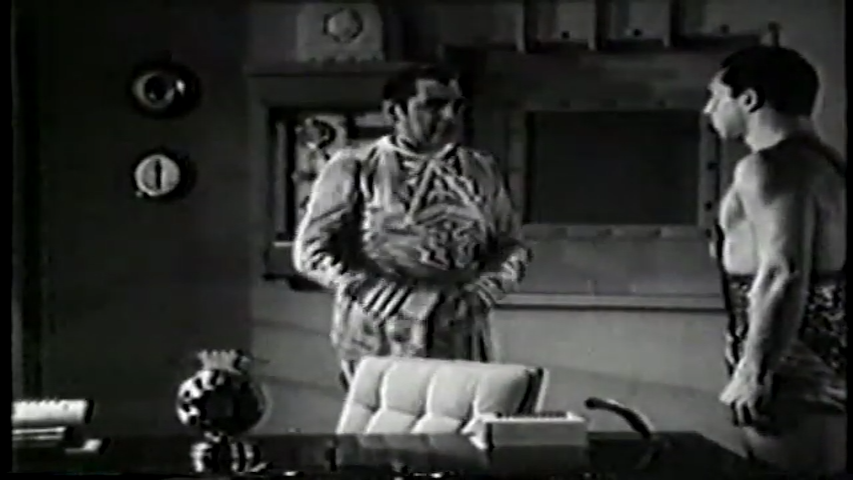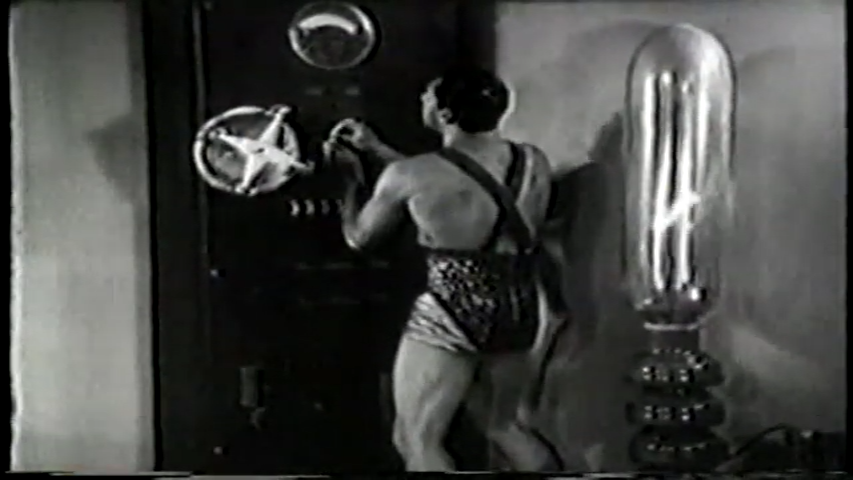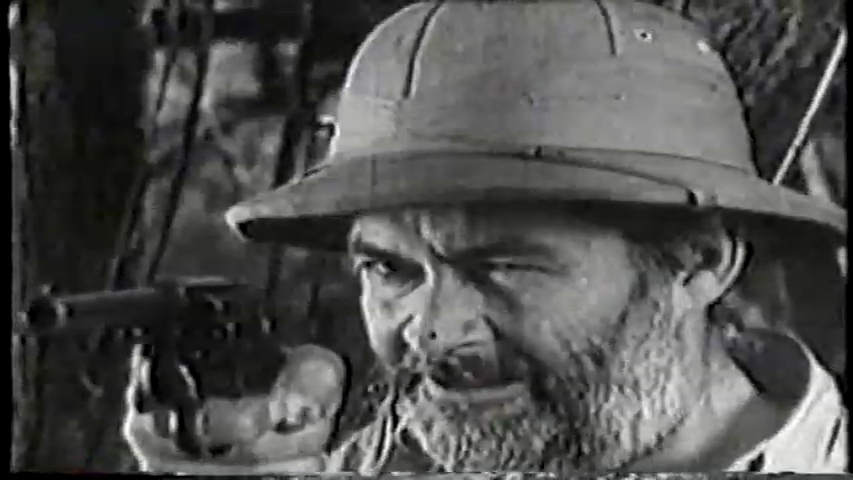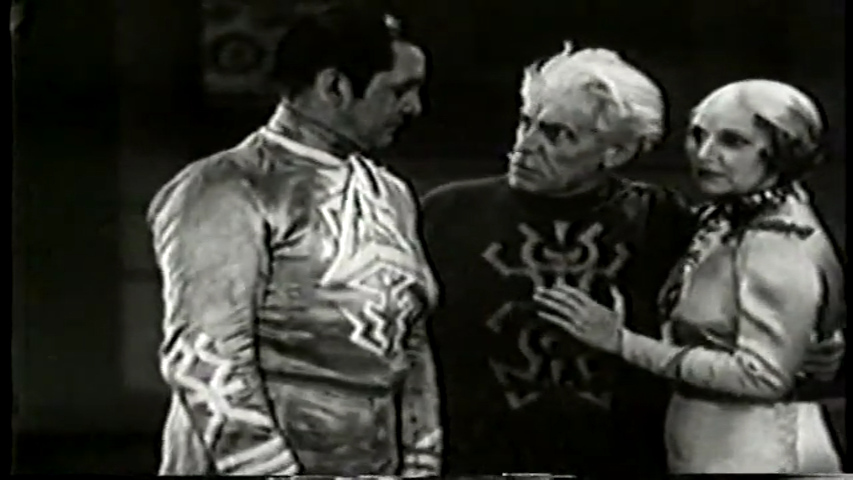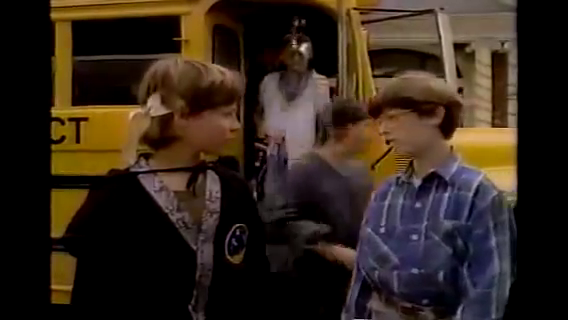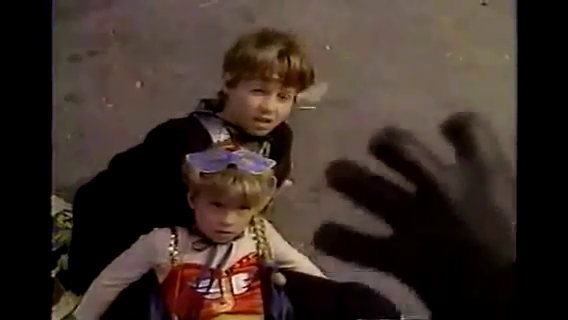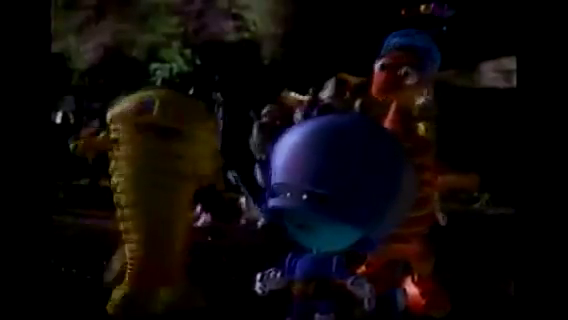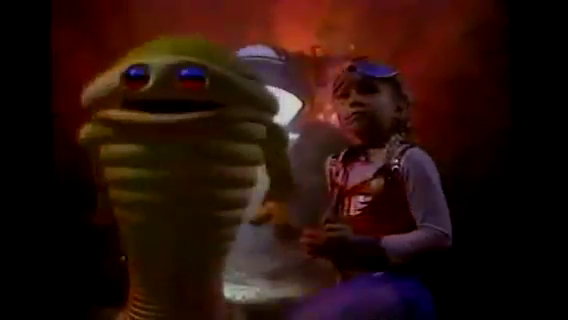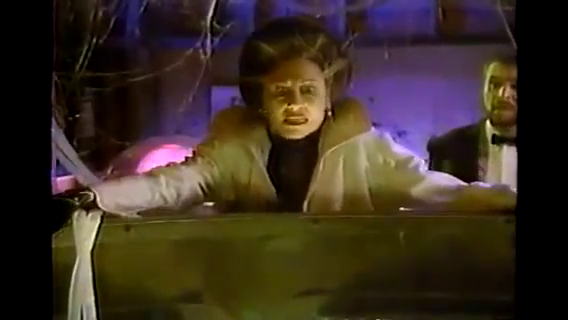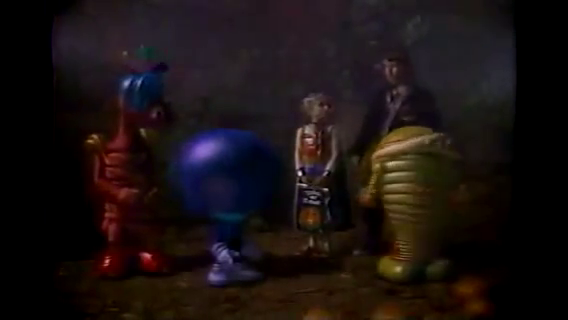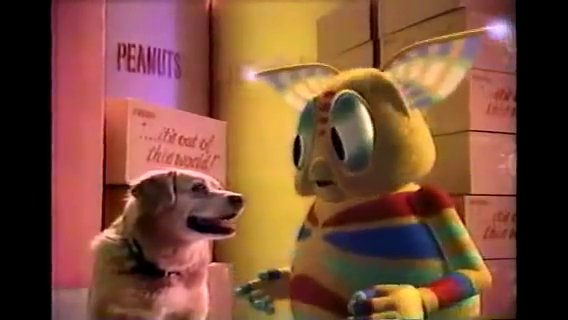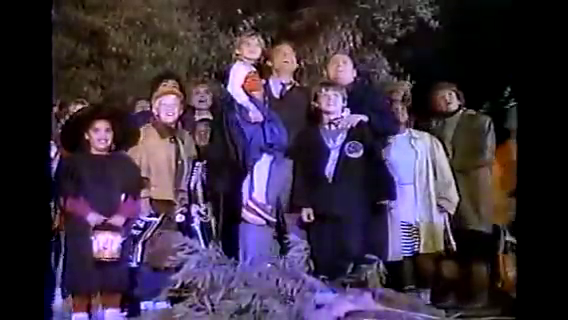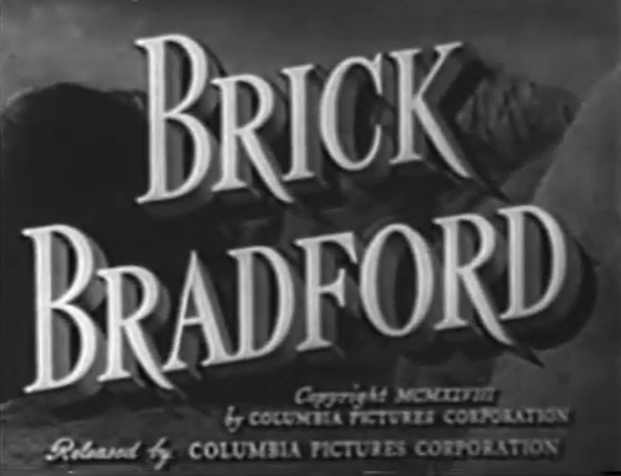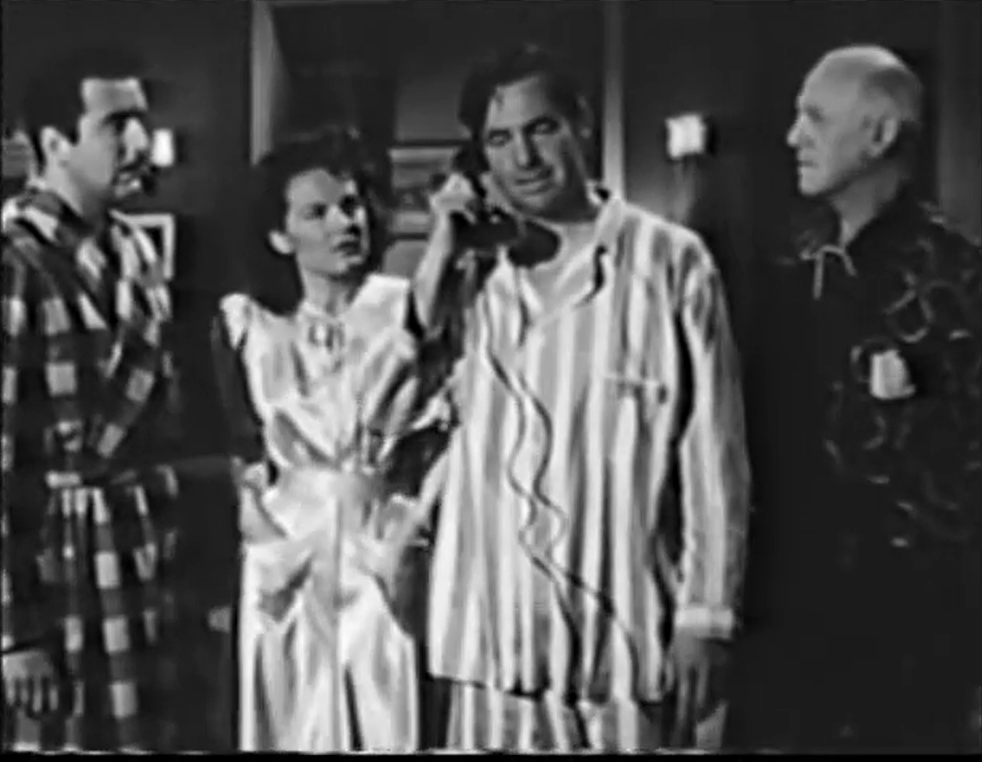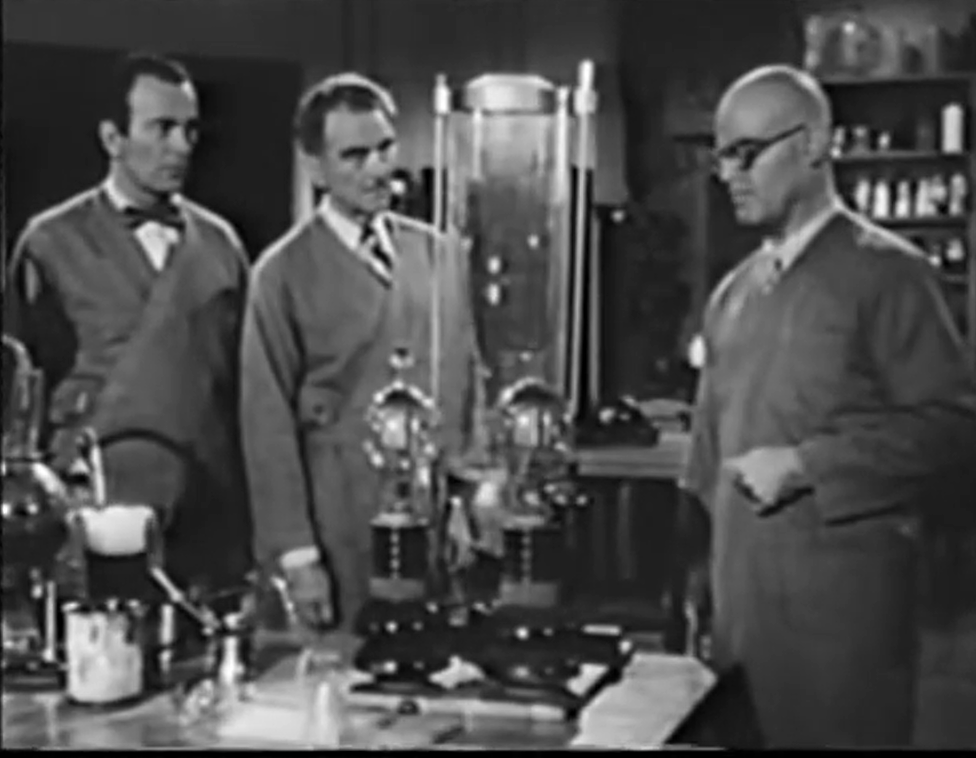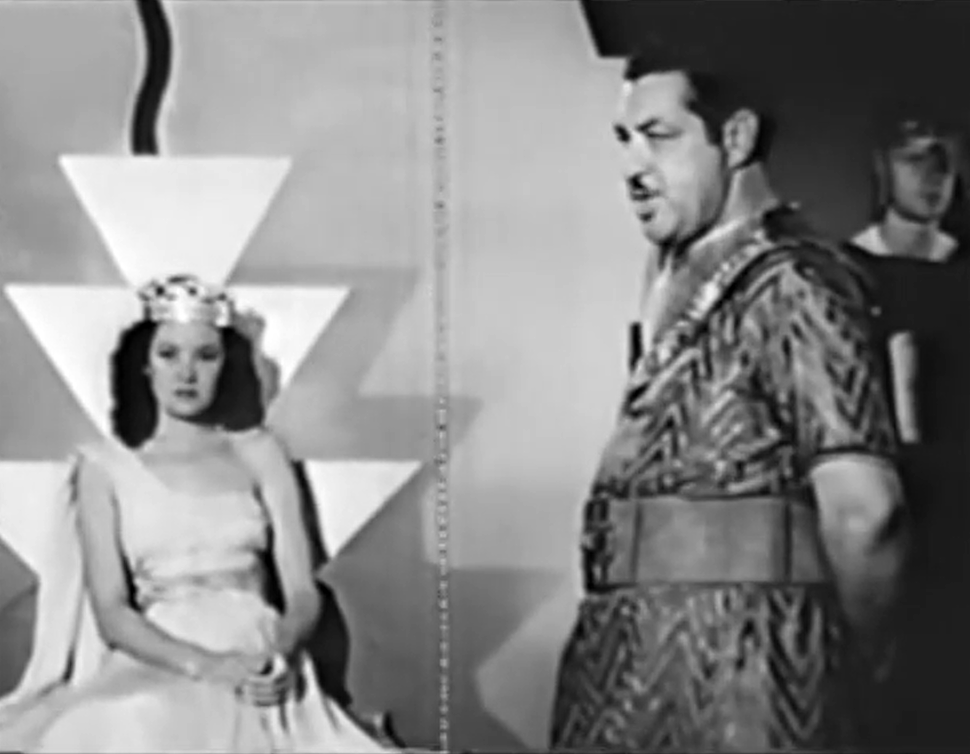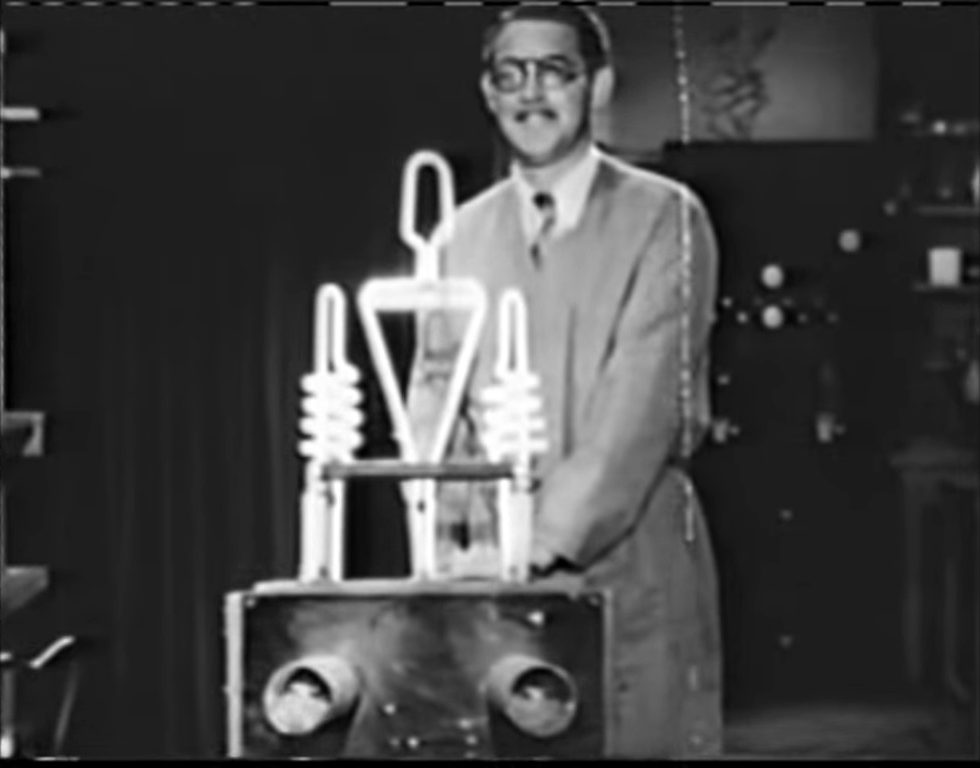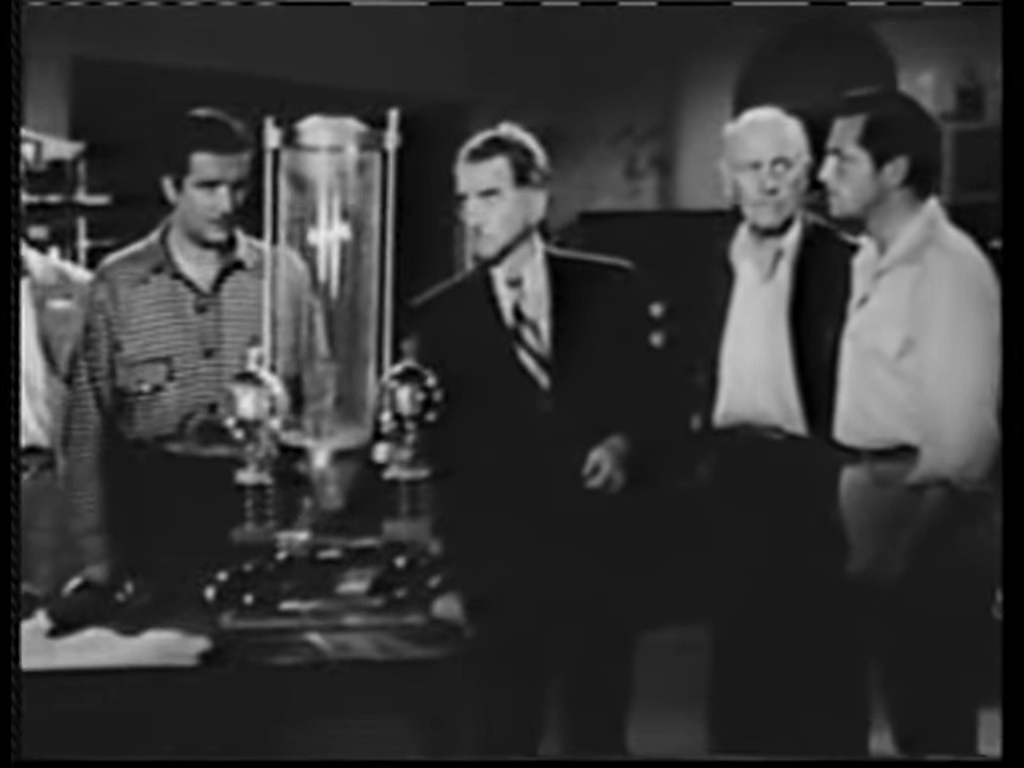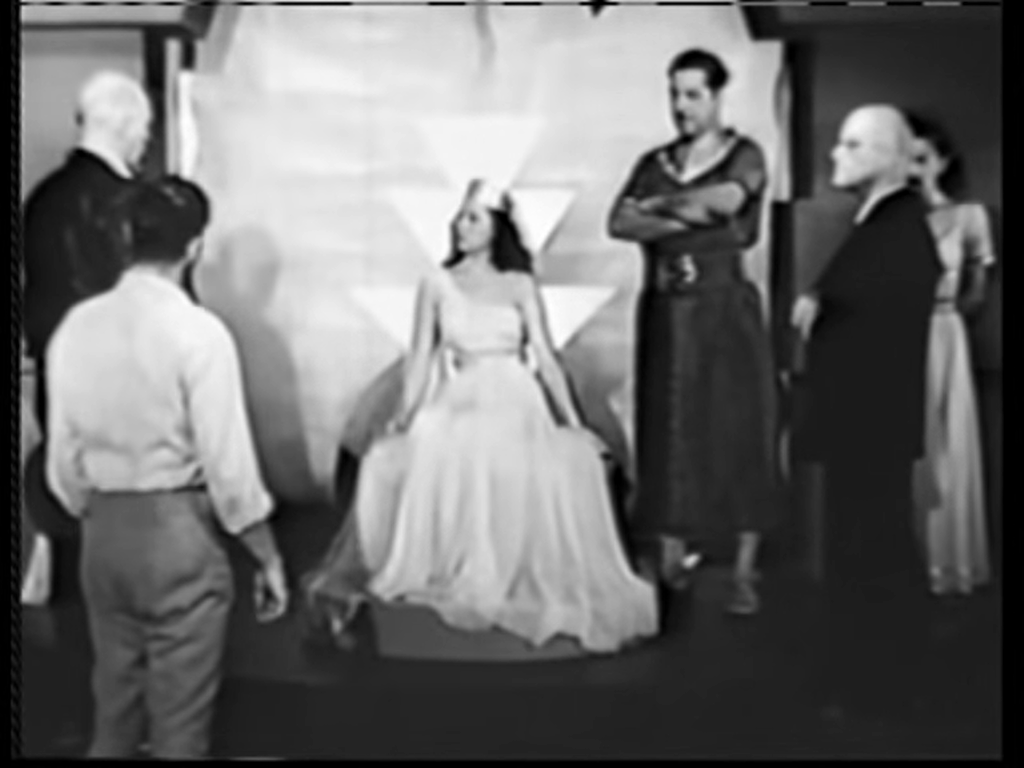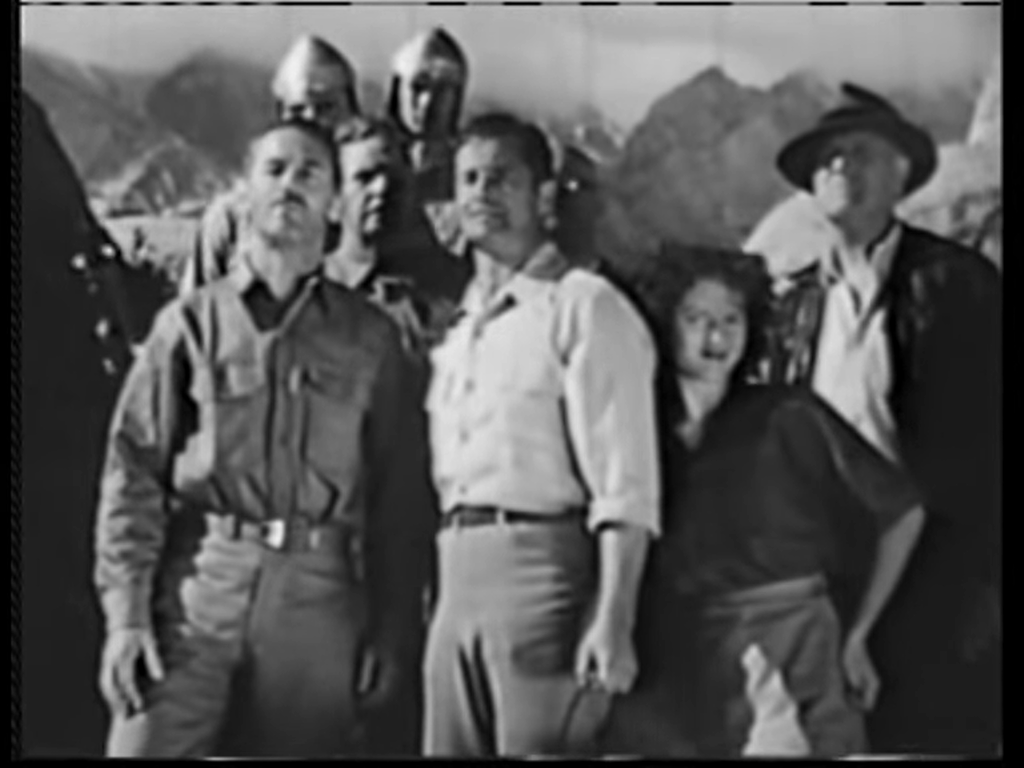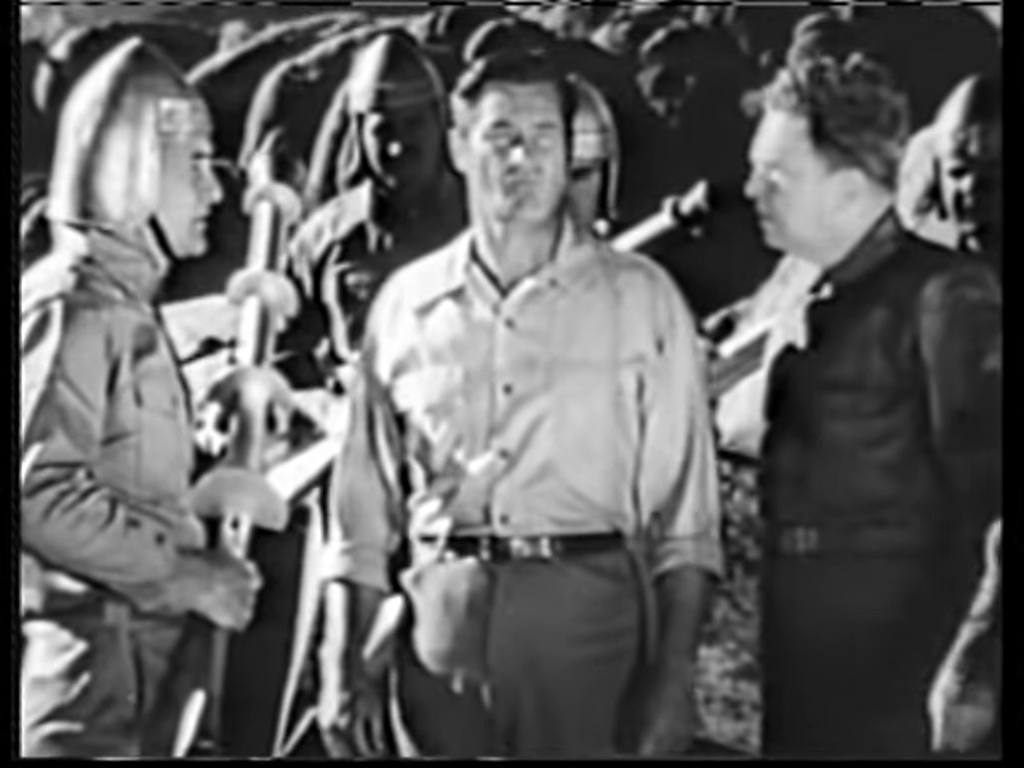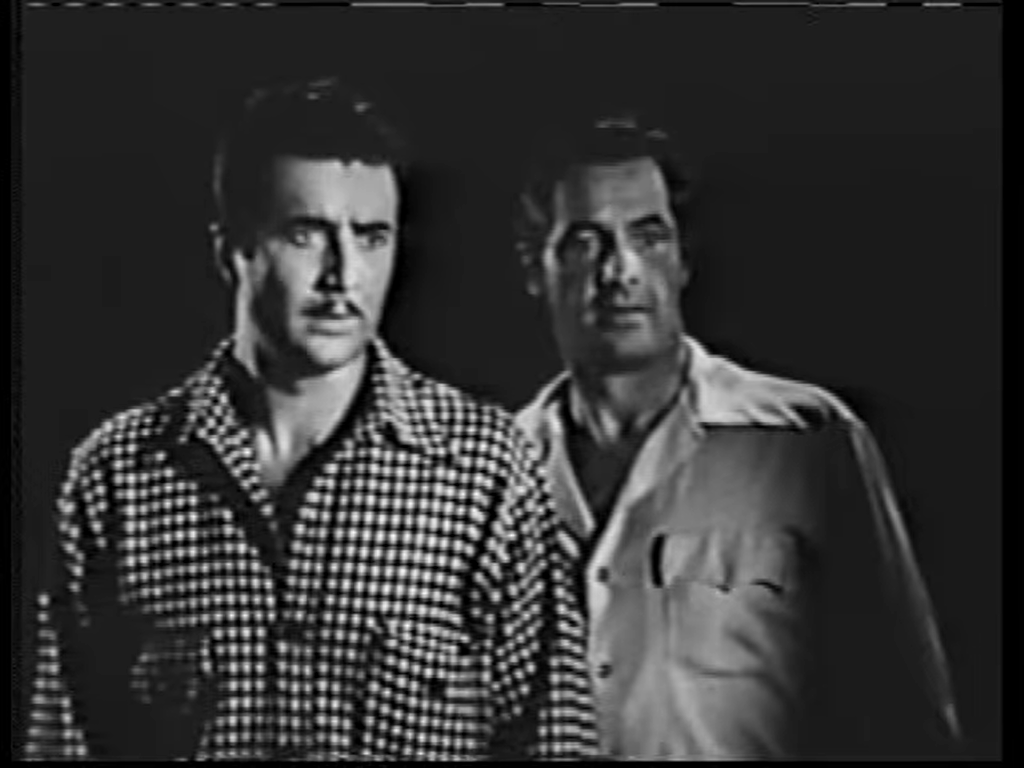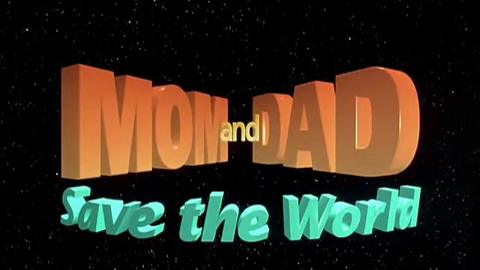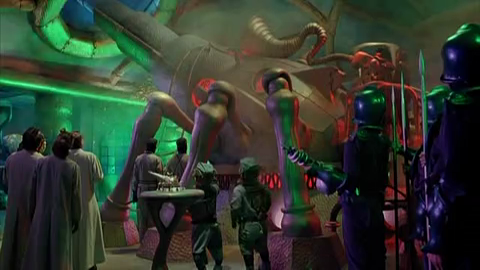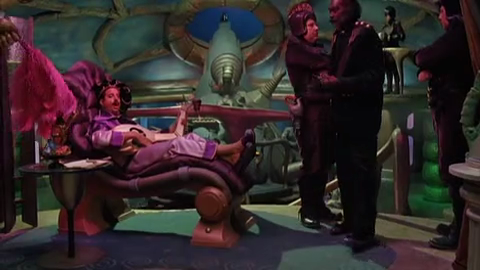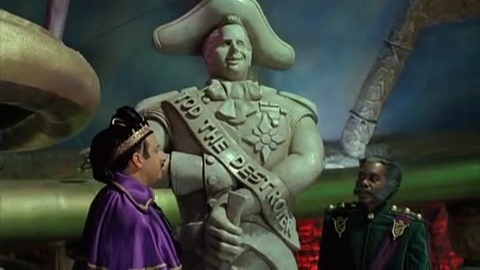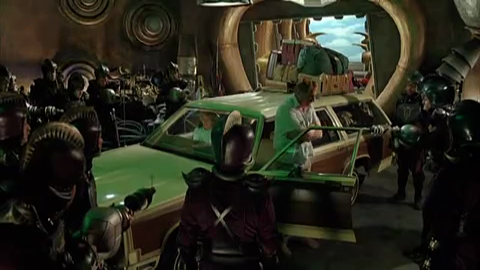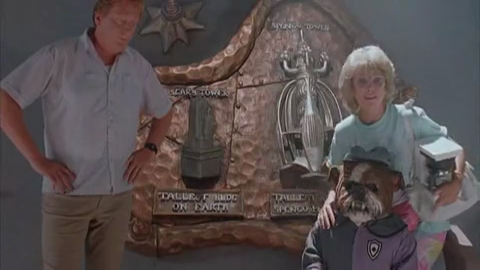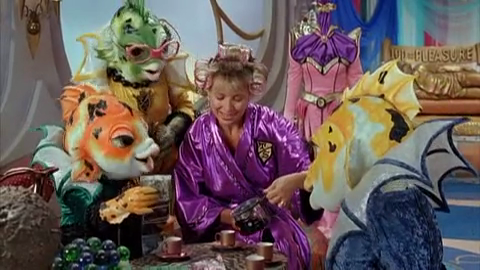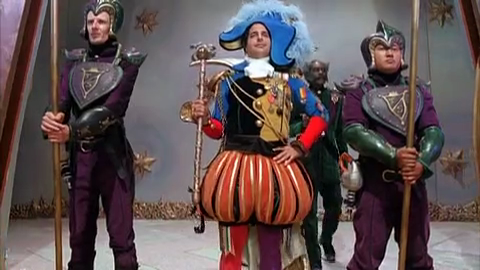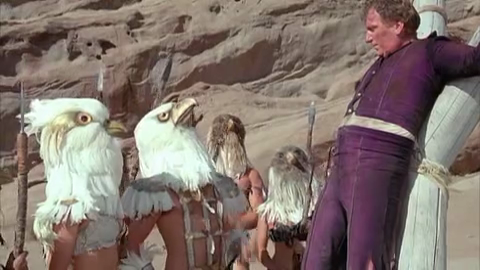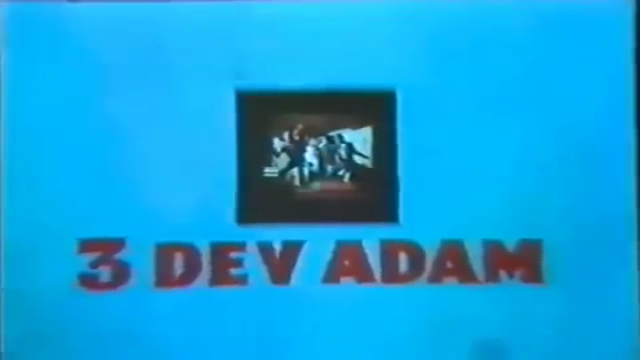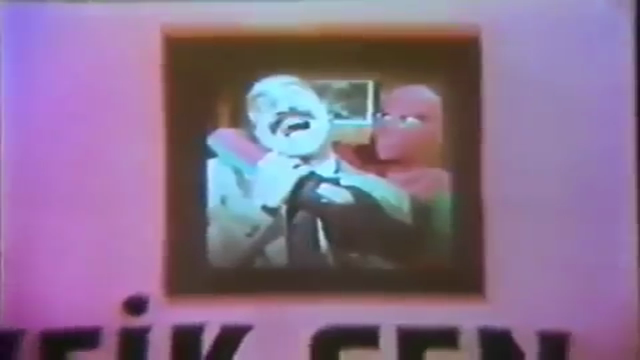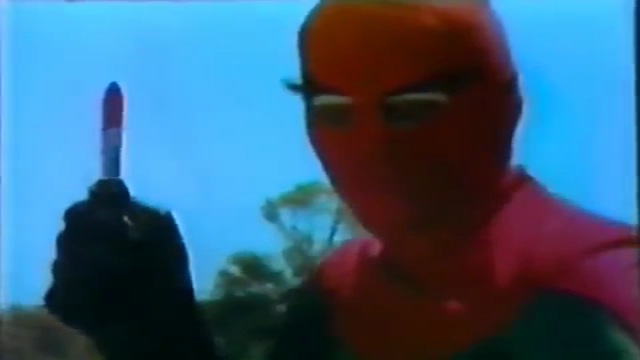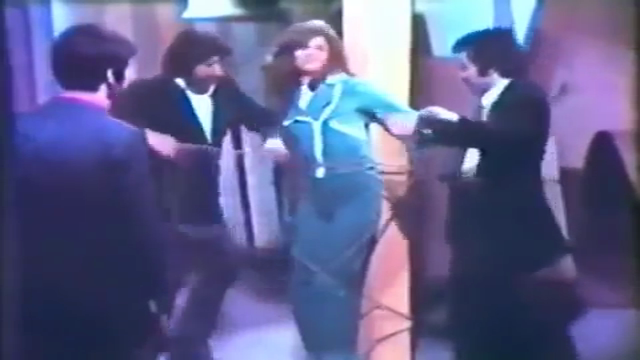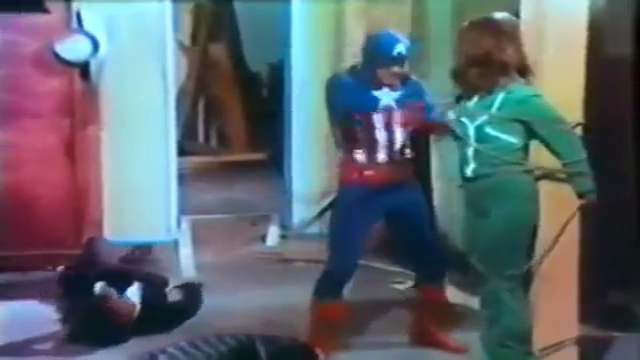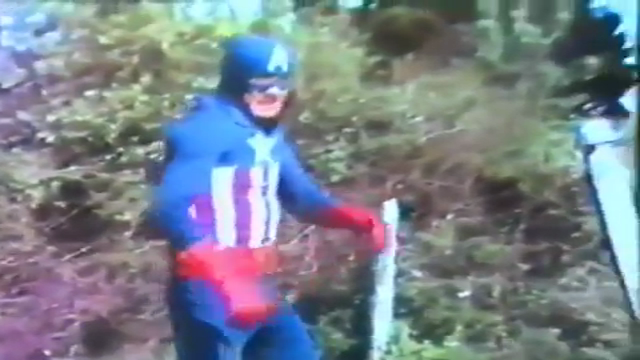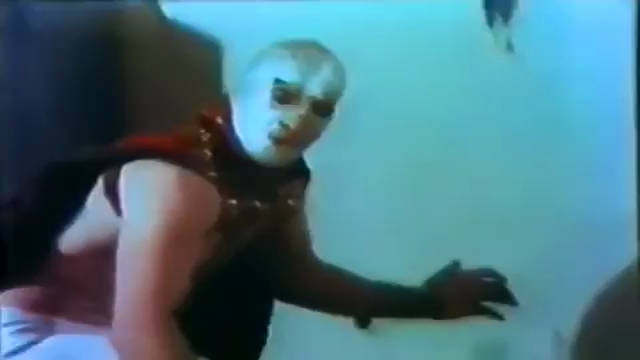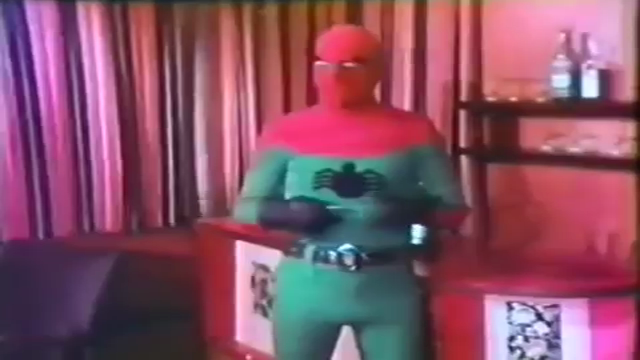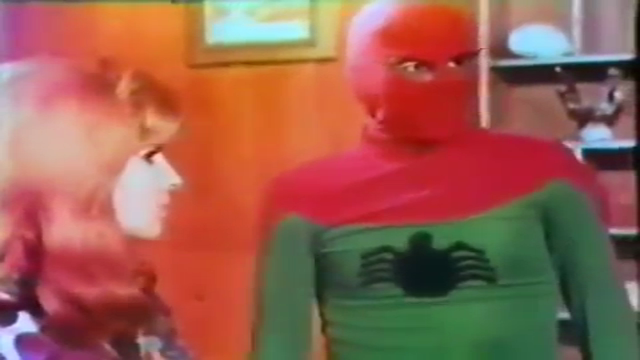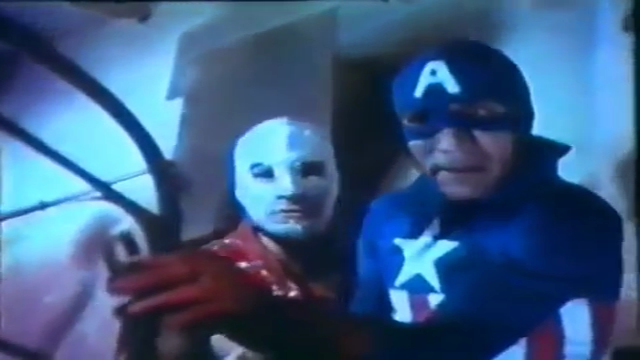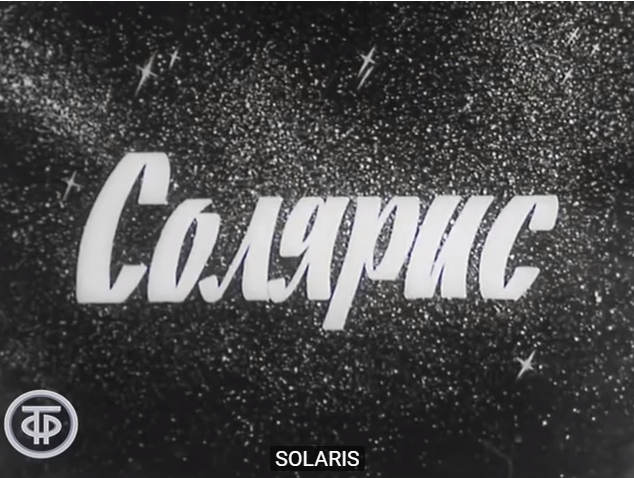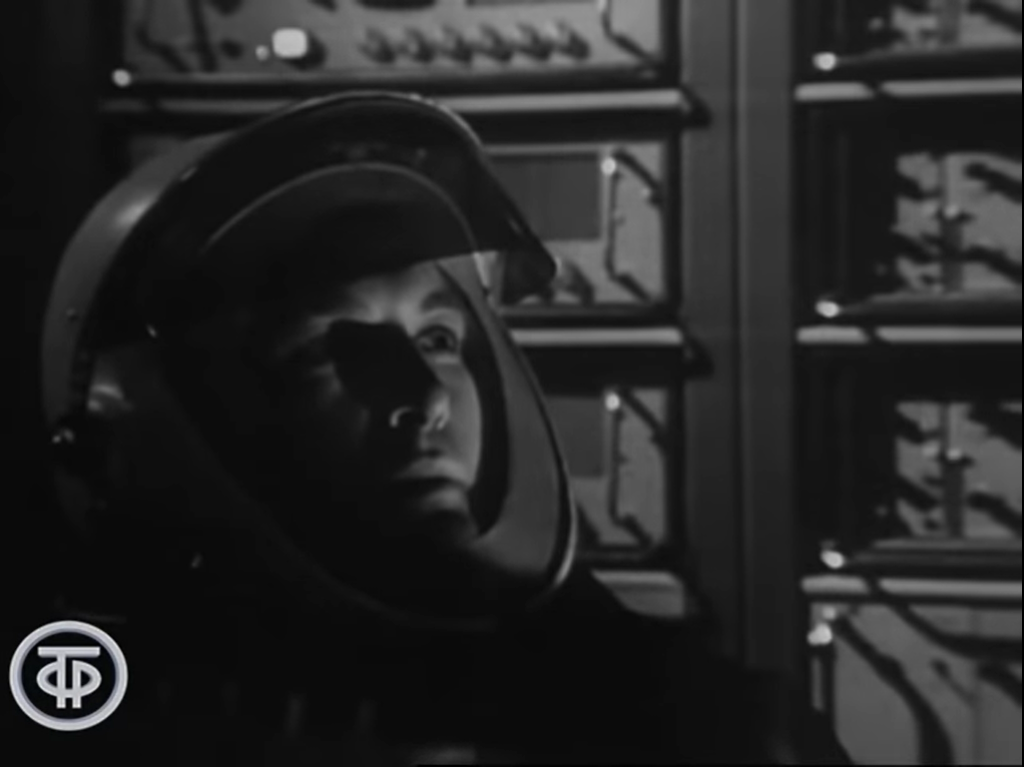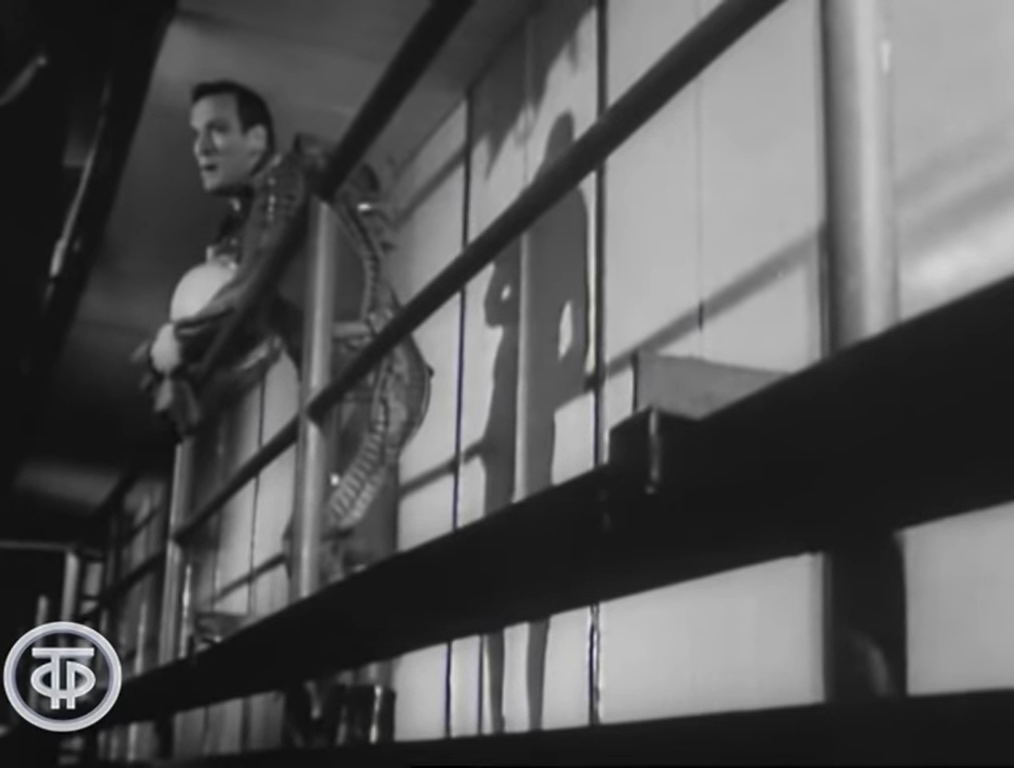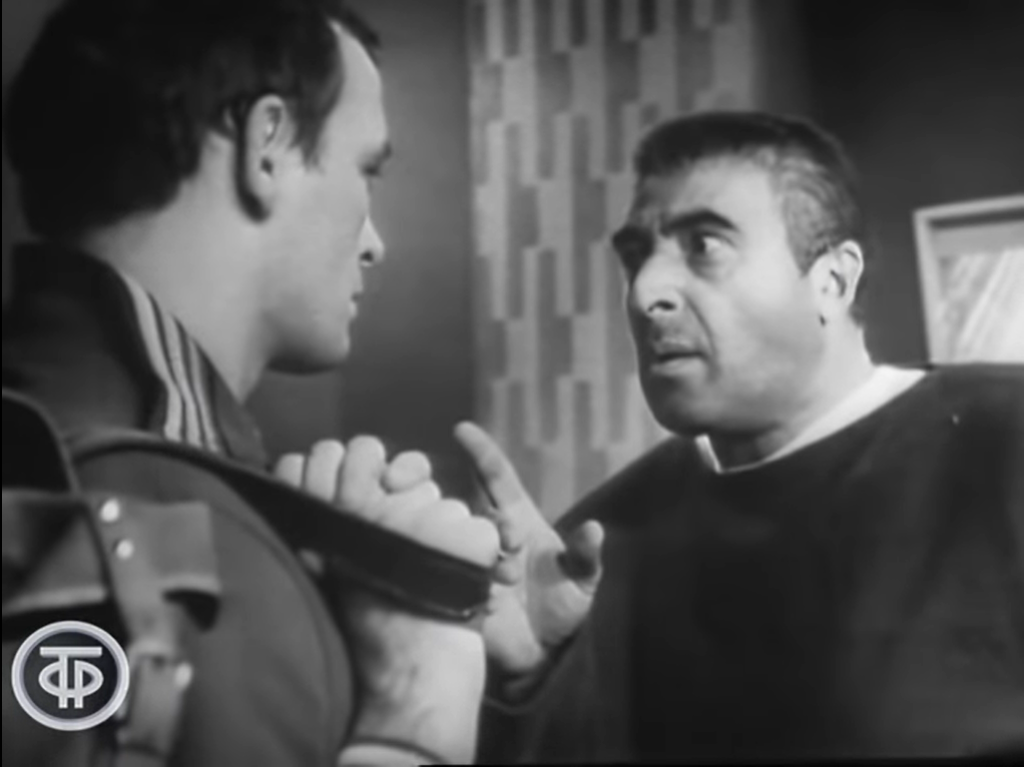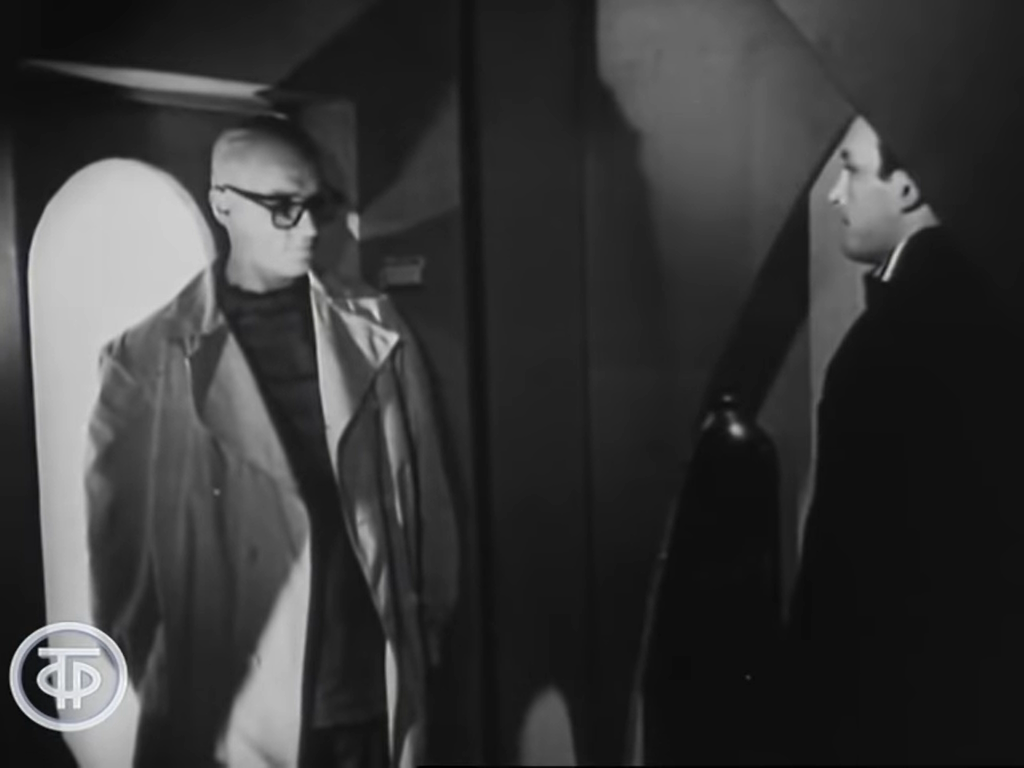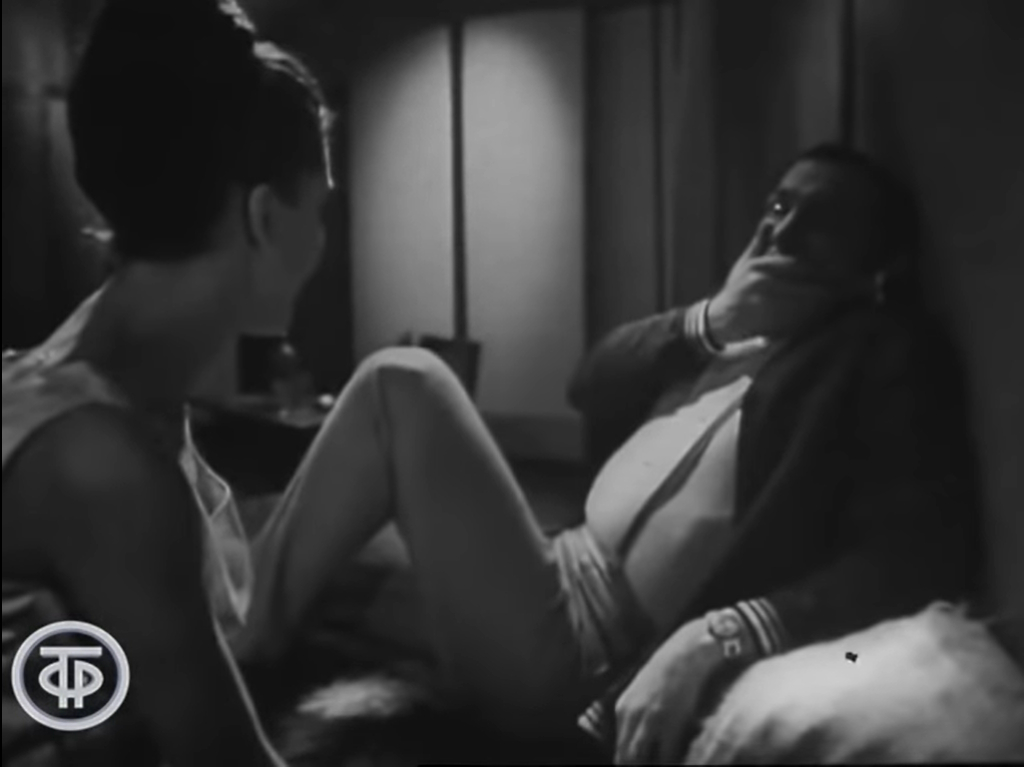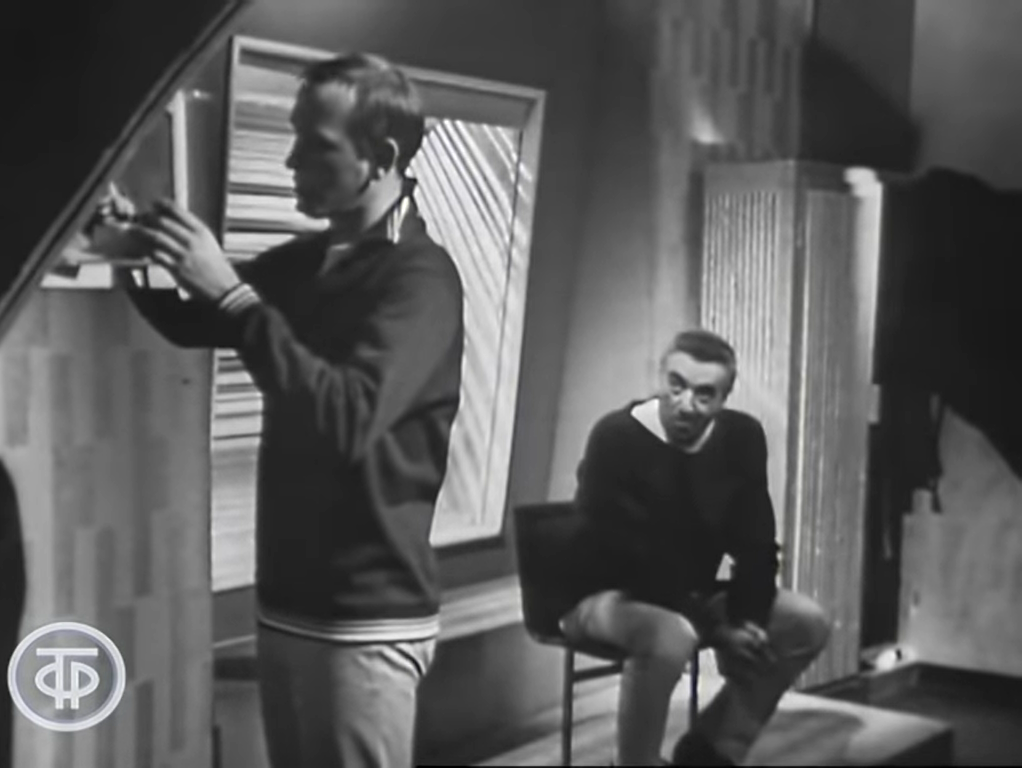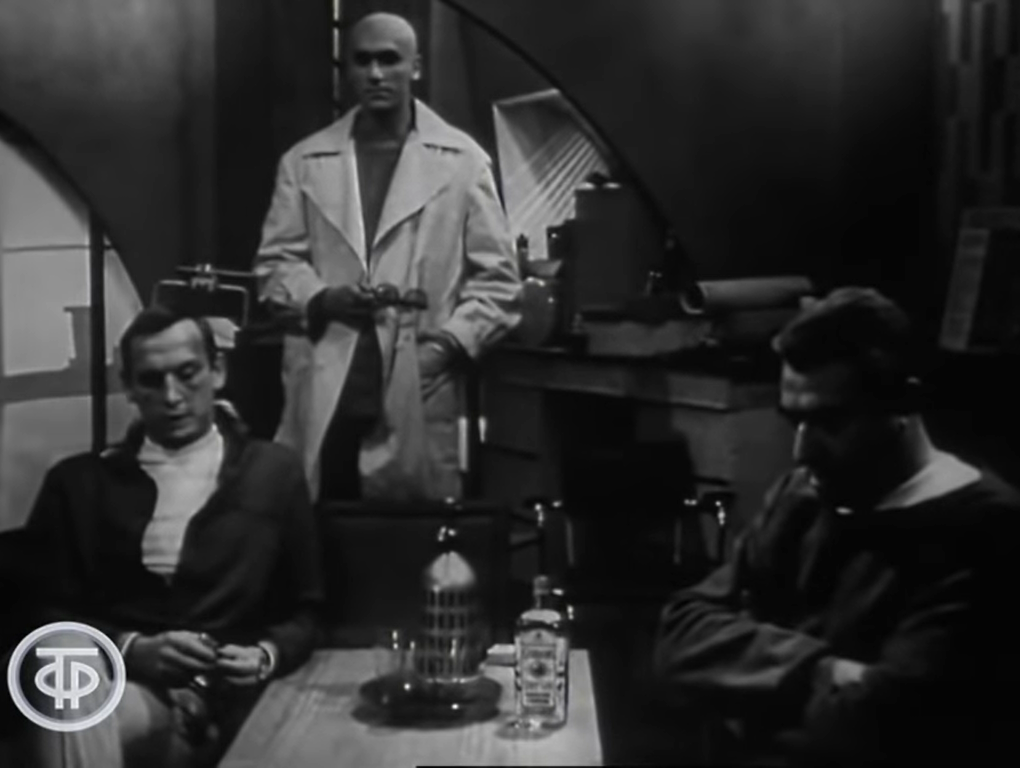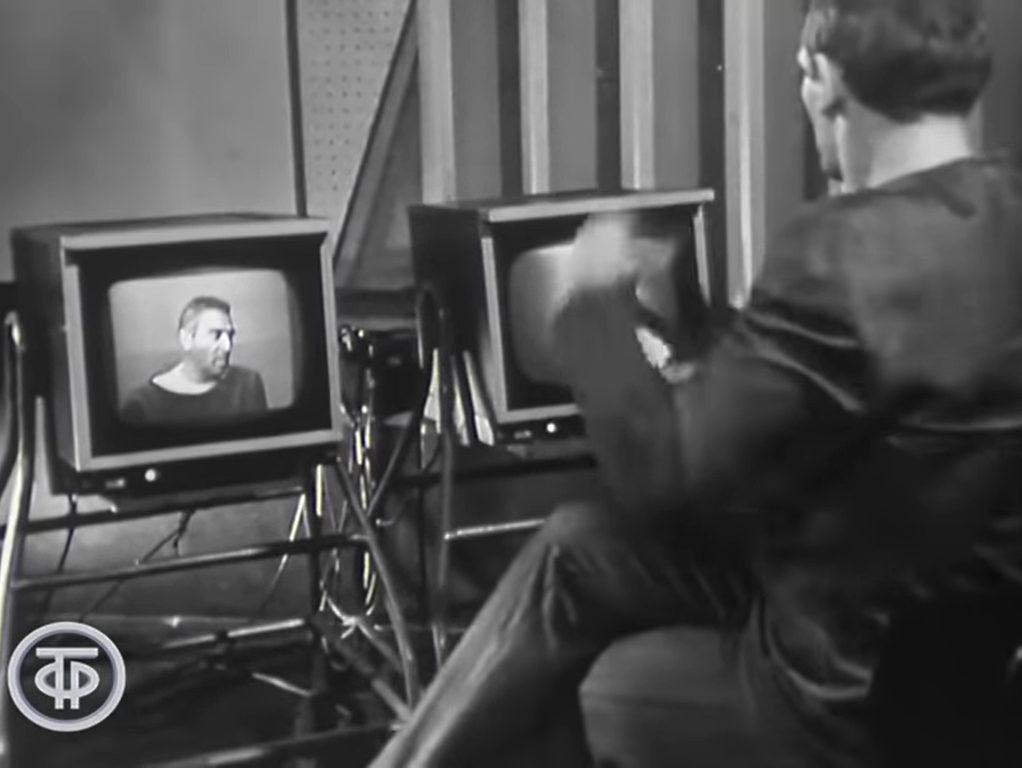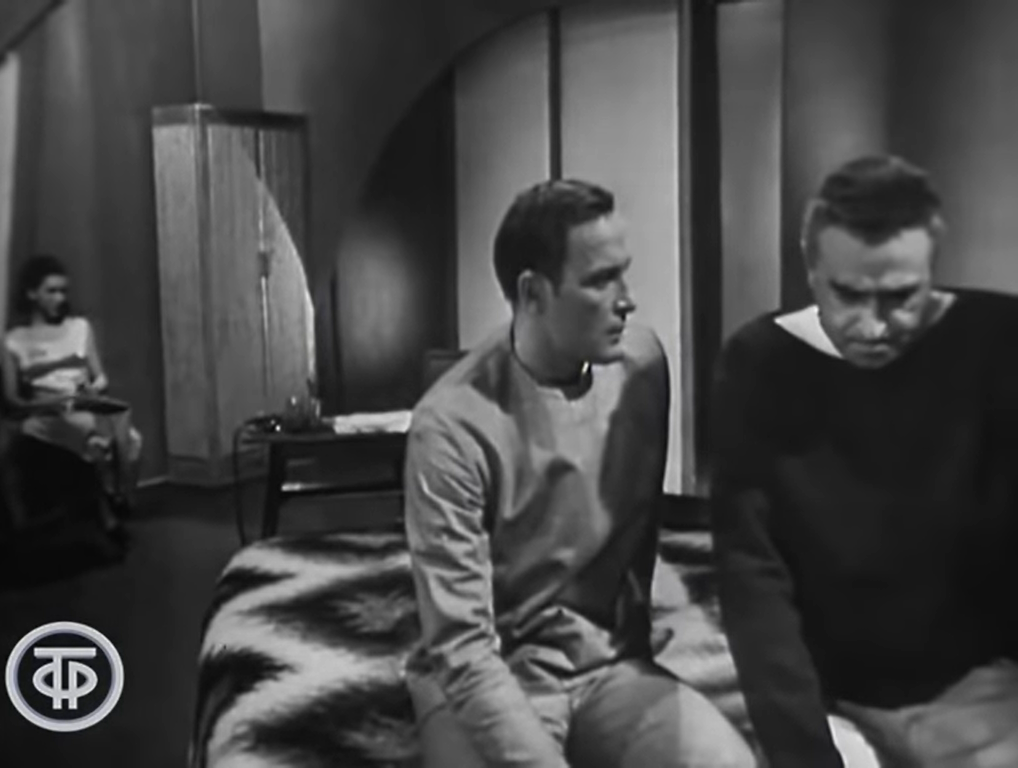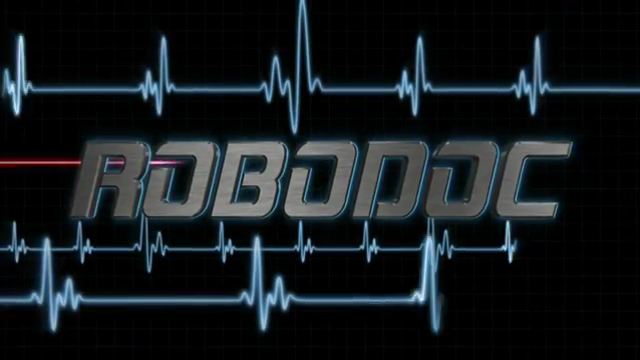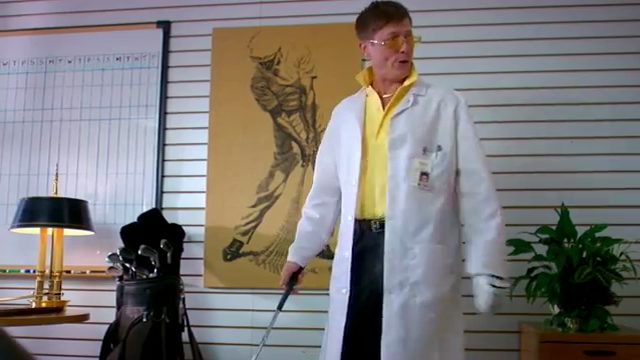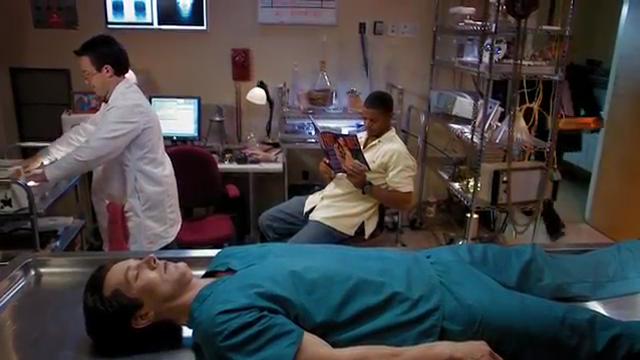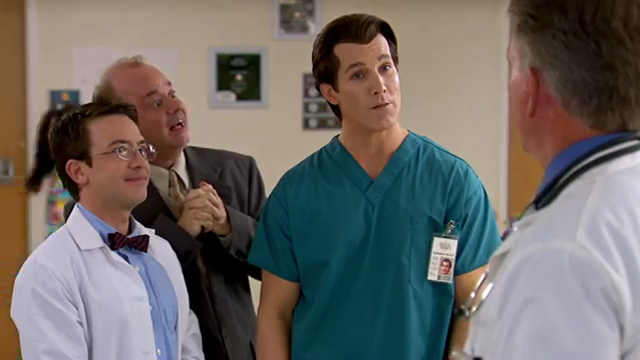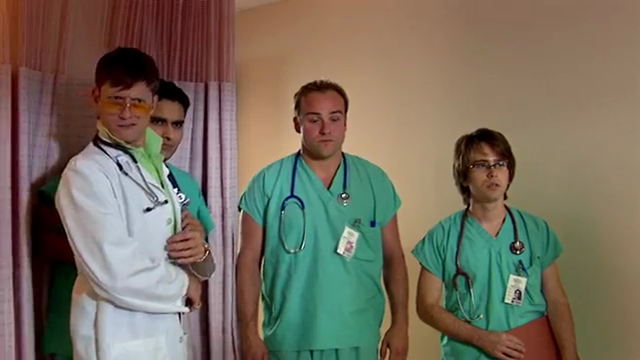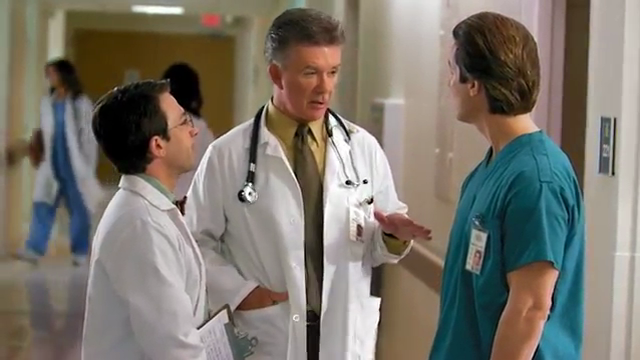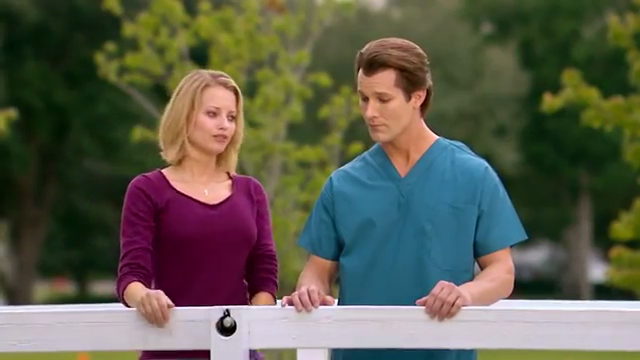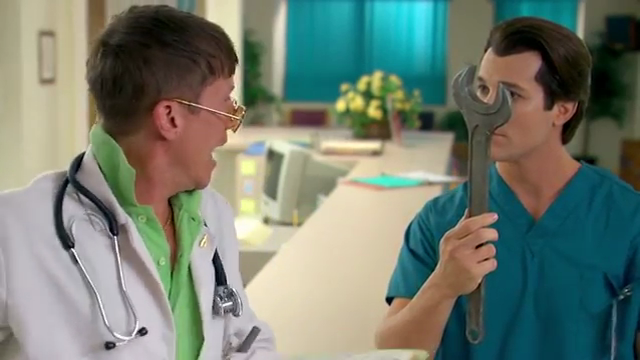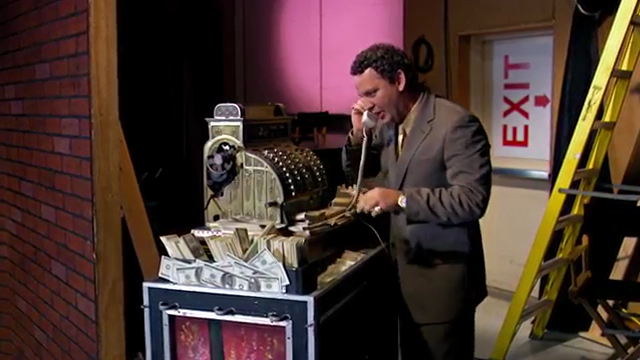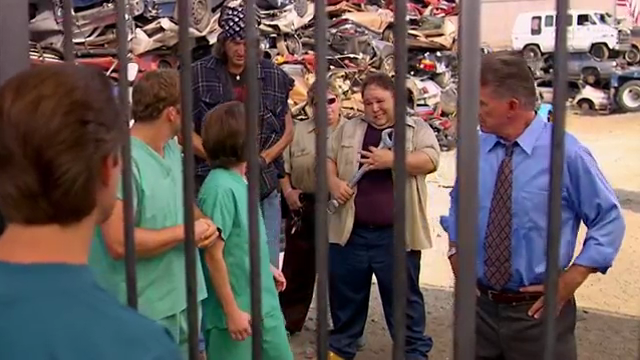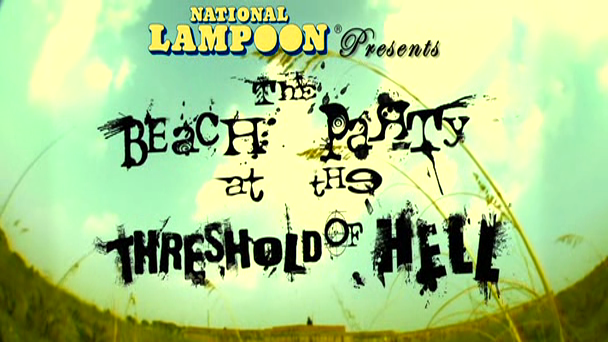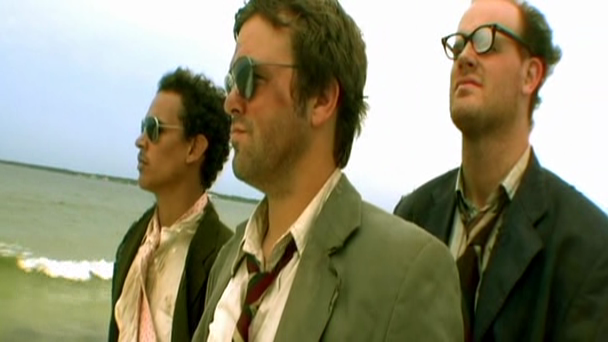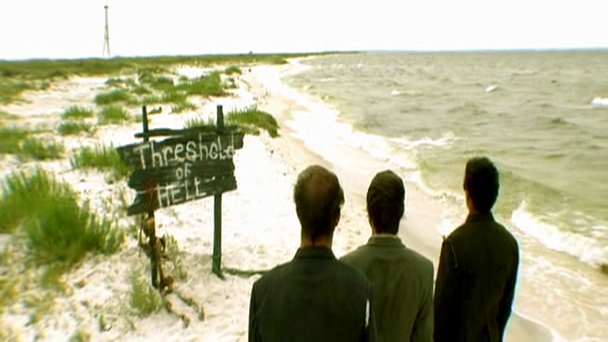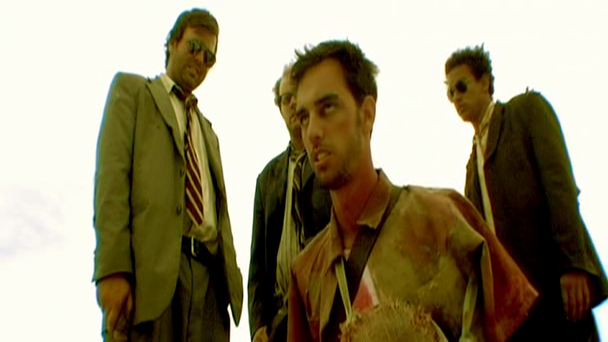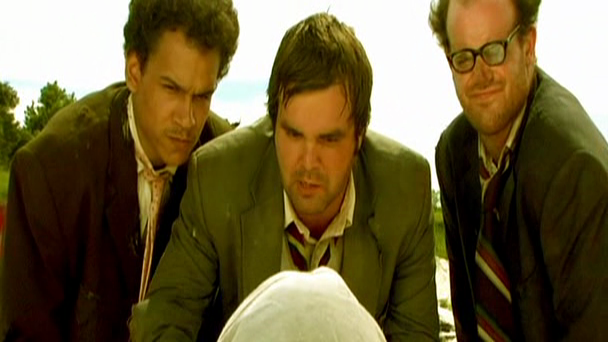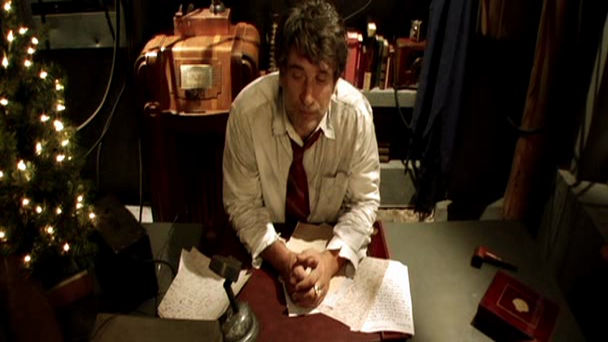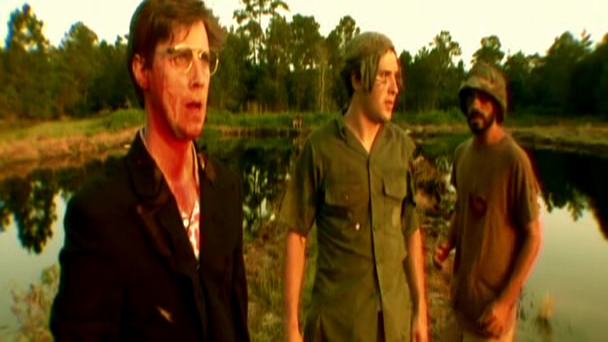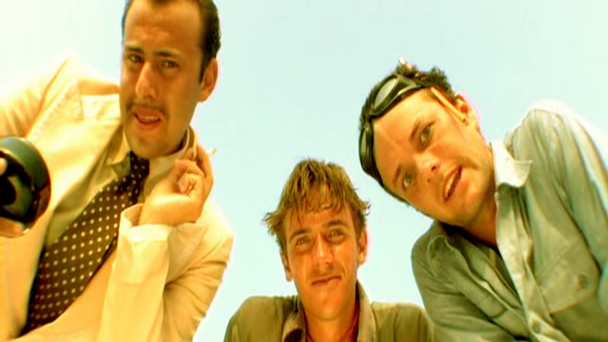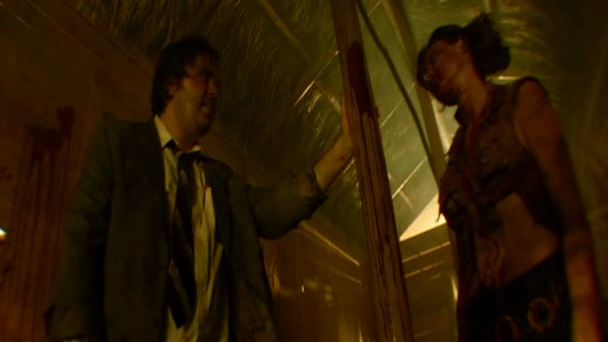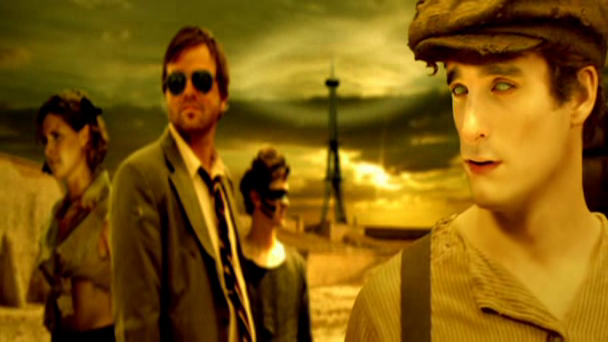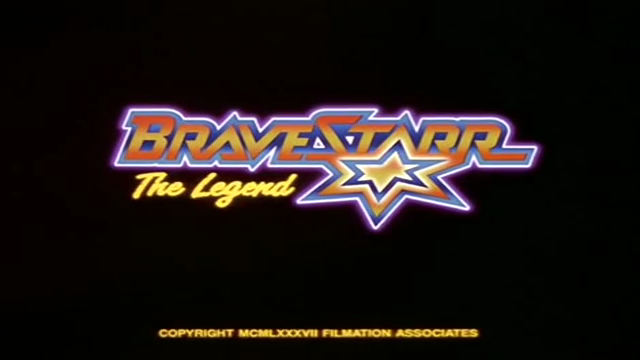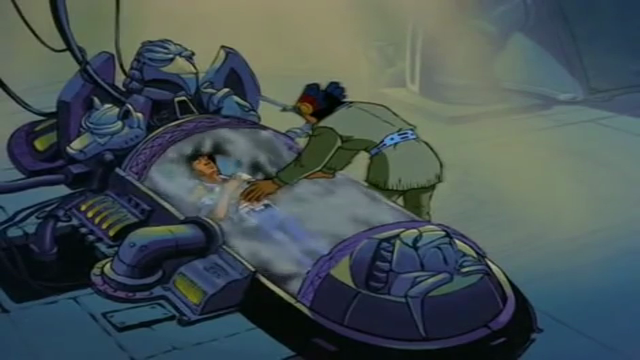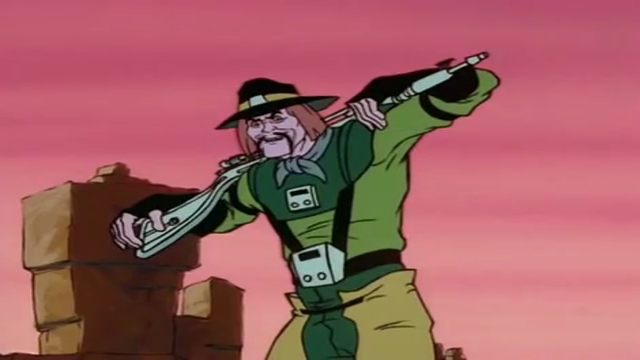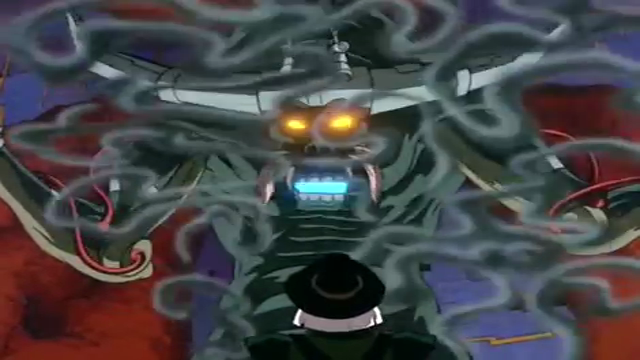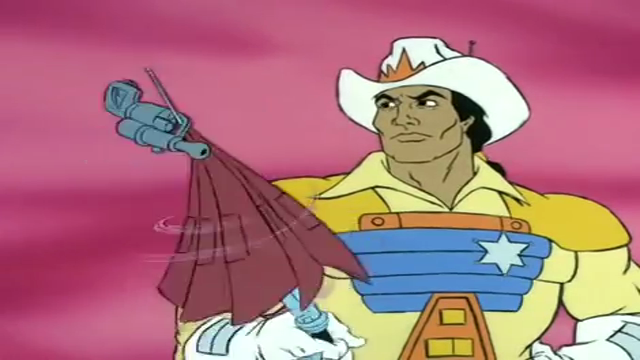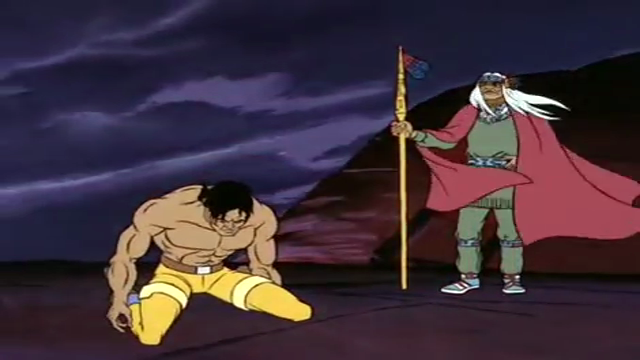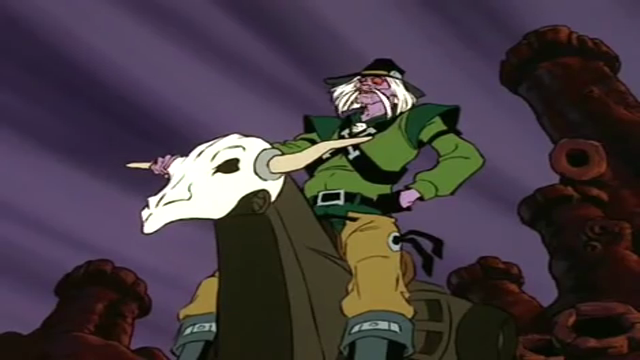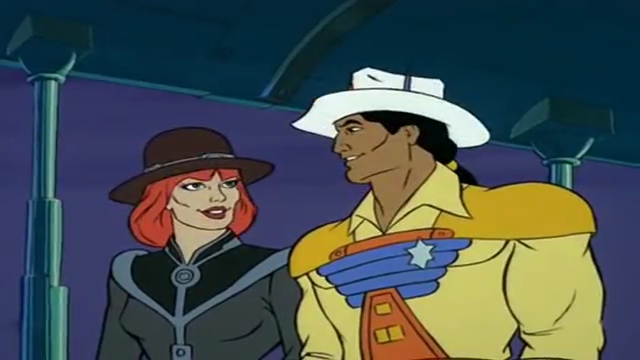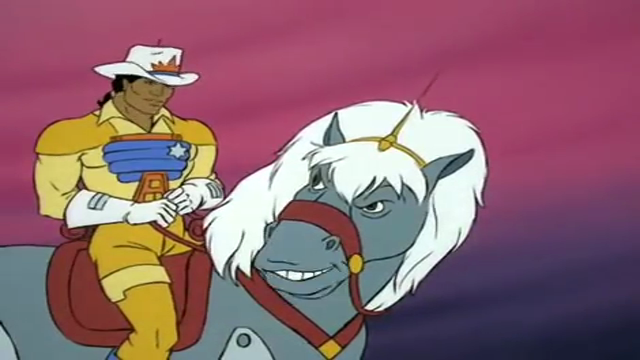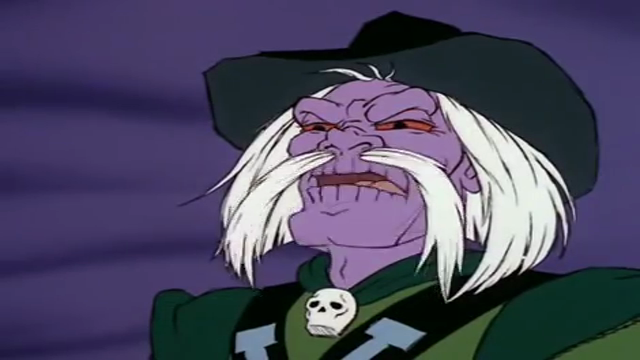-
#376 – The Mad Monster (1942)
The Mad Monster (1942)
Film review #376
Director: Sam Newfield
SYNOPSIS: Dr. Cameron, a scientist, has been experimenting with genetic modification, a practice which has left him the subject of ridicule and forces him from his university job. Out in the country, he experiments on his hired help Pedro to turn him into a werewolf, but when Pedro starts killing people in his werewolf form, Dr. Cameron finds it increasingly difficult to keep his experiments a secret…
THOUGHTS/ANALYSIS: The Mad Monster is a 1942 horror/sci-fi film. The film centres around Dr. Cameron, a scientist whose experiments in genetic engineering have left him ridiculed and cast out of the scientific community. He moves out into the country with his daughter Lenora to carry on his experiments, using his hired help Pedro as a test subject. Cameron successfully develops a serum that can turn Pedro into a werewolf-like creature, which ends up escaping and killing a little girl. Pedro is unable to remember the time when he is transformed, so Cameron uses this to his advantage to take revenge on those that ridiculed his research. The story is quite straightforward, and there’s no real surprises. The plot is all explained at the beginning, and it is up to the characters to unravel the mystery themselves. there’s nothing really special about the film, it’s another simple story of science going too far that has been done many times before (and after).
The film attempts to create a horror atmosphere through some creative use of lighting and dark, minimal sets. Although all the violence happens off-screen (this is the 1940′s after all), so it is difficult to get much of an idea of how vicious this werewolf creature is. The cast of characters is pretty bland, but well defined, and everyone contributes to the story in some way. The acting and delivery of lines is sometimes a bit flat, but credit to the actor playing Pedro, who gives an expressive performance. One of the biggest drawbacks of the film is that it often feels boring, with scenes that drag on too long consisting of dull conversations that go nowhere. You become very aware of the beginning and ending of scenes as they mostly end on flat notes without much fanfare, leaving you to wonder what the point of it was.
As mentioned, the production values of the film are rather low, owing to the general state of the world at the time and having more pressing issues to address. Nevertheless, there are a few positives, such as Pedro’s “werewolf” make-up or costume being quite well put together. Sometimes Dr. Cameron delivers a good speech under an atmospheric light, but other than that there’s really not much else that stands out. The Mad Monster is an entirely forgettable film with a typical message of science going too far, and a blandness in terms of its looks and its dialogue leave little to recommend it.
-
#375 – The Lost City (1935)
The Lost City (1935)
Film review #375
Director: Harry Revier
SYNOPSIS: Extreme weather is causing mass destruction across the Earth, with seemingly no known explanation. Electrical engineer Bruce Gordon manages to use one of his machines to trace the source of these disturbances to an unexplored region of central Africa. He leads an expedition to the area to investigate and ends up discovering a lost city ruled by a madman who is intent on attaining absolute power from his machines. Bruce must join forces with the various people in the region, and stop the evil Zolok from using his machines before the world is destroyed…
THOUGHTS/ANALYSIS: The Lost City is a 1935 science-fiction, twelve part film serial. in the opening, we see storms ravaging the cities of the world, causing mass destruction. The world is unable to find the cause of these freak weather events, until electrical engineer Bruce Gordon uses one of his inventions to locate the source in an unexplored region of central Africa. Bruce leads an expedition to the area withe his friend Jerry Delaney, and when he arrives at a trading post, a man named Butterfield stumbles in injured, telling of a lost city beneath Magnetic Mountain guarded by giants. Believing there is a connection between Magnetic Mountain and the storms, Bruce investigates and finds the lost city is real. There, a man named Zolok is forcing Manyus, a scientist, to construct inventions which he believes will help him rule the world. The opening chapter of the serial is typically full of exciting effects and setting the stage for a thrilling adventure. As I’ve mentioned before in other serial reviews, the opening chapter is often the most thrilling and interesting, as it is meant to entice viewers to return to the theatre every week to watch the subsequent parts. These serials can quite quickly run out of steam, as they are made on a low budget and there is a lot of re-used settings and back-and-forths between the heroes and villains that can get repetitive. With The Lost City though, this repetition is kept to a minimum as there’s a number of distinct locations, and a large cast that gets introduced as the story goes on, so these new elements continually change the dynamic of the plot. Of course, there’s also plenty of daring cliffhangers at the end of each chapter, with lion pens, giant spiders and all sorts of devious traps that will encourage viewers to return next week. The overall story is definitely stronger than many similar serials I have seen.
As I mentioned, the cast is fairly large, and are somewhat diverse. The “giants” are pretty cool, and have a menacing presence. The big problem here though, with the film being set in central Africa, is the film’s depiction of non-white races. The “native tribes” are portrayed as very typical, primitive people as very much stereotypes of what western countries at the time were taught Africa to be. The fact that the film does not further pinpoint the location other than “Africa” again shows how the entire continent is ill-defined by said countries. When the “Arabs” shows up around half-way through the serial, they again are portrayed in a stereotypical fashion. Both of these groups, when they are supposedly speaking in their own language, is clearly just gibberish being shouted by the actors, which again just reinforces the dismissive attitude to non-white cultures. i think the main villain is designed to be similar to an east Asian person as well, just to round off the serial’s inclusion of all races. The portrayal of the black giants is clearly meant to make them as menacing as possible too. On top of all this, there is a plot element that Manyus has invented a medicine that can turn black people white. While the film does not label this as a “cure” for being black, it does feel that way at points, and really just compounds the fact that this film is horrifically outdated, and racially dismissive/ignorant.
The Lost City really shines through in terms of its story, and it paces itself well throughout the twelve chapters by continually introducing new characters and dangers in order to keep things fresh. In this respect, it avoids one of the significant problems that plague the serial format. However, it’s depiction of non-white races is horrifically ignorant and outdated, and really is non-redeemable. Yes, it is a product of it’s time, but I do not feel that it is enough of an excuse to dismiss its harmful racial depictions.
-
#374 – The Last Halloween (1991)
The Last Halloween (1991)
Film review #374
Director: Savage Steve Holland
SYNOPSIS: In the town of Crystal Falls, Michael and his younger sister Jeanie are eager to celebrate Halloween, but their Father, who owns the local candy factory, fears this will be “The Last Halloween” as the lake that powers the factory is mysteriously drying up. When aliens show up looking for something called “koobi” which their home planet of Mars has run out of, Michael and Jeanie help them to find some and unravel the mystery of the lake along the way…
THOUGHTS/ANALYSIS: The Last Halloween is a 1991 TV film/special aired at Halloween (Unsurprising, given the title). In the opening we are introduced to Michael and Jeanie: a brother and sister who live in the quaint U.S. town of Crystal Falls. Their Father and grandfather run the local candy factory, which is about to close down due to the mysterious drying up of the lake, which will make a lot of the town unemployed. Michael and Jeanie are still looking forward to going trick or treating however, and their Halloween night gets even stranger when four aliens land on Earth looking for something called ″koobi” which their home planet of Mars has run out of. Michael and Jeanie agree to help the aliens out, but meanwhile Mrs. Gizbourne is secretly using the water from the lake to fuel her experiments into attaining the secret of eternal youth. For a television special that only runs at around twenty five minutes, there is a lot going on in terms of story and characters. It crams a lot in so that in theory there’s something for a wide audience. It skips a lot on some of the details, but that kind of thing doesn’t really matter to kids, who can happily fill in the gaps with their own imagination. With all these different threads going on at the same time, the special nevertheless flows along quite nicely, and there’s always something fun or interesting happening on screen.
The film is definitely meant to have a “timeless” quality to it, so it can be repeated every year when halloween rolls around. It’s meant to be the sort of film that becomes part of the tradition, although it wasn’t shown much after it’s original airing as far as I can see, and there’s been no digital or home video release. Michael and Jeanie are plain and average children that younger viewers can relate to, but they have their own unique traits too. The aliens are probably the most interesting characters though, as each has their own look, voice and personality, and are entirely computer-animated, which was quite groundbreaking at the time have CG creatures interacting with real actors on-screen. This special was made my Hanna-Barbera, who produced a lot of traditional hand-drawn animated shows (Scooby-Doo, The Flintstones, amongst others), and this is one of their first forays into computer-generated animation. Nevertheless, they seem to have transitioned well, and the aliens all look, move and talk like they have a genuine presence. Obviously the effects look dated now, but again there is still a timeless quality to them that doesn’t spoil the overall feel of the story.
Overall, The Last Halloween, while being short and fairly harmless, manages to cram a lot of content into its runtime, with plenty of elements that will appeal to its younger audience. It plays it safe in many respects and is mostly harmless, probably appealing to well-established ideas to make it “timeless”, but owing to that, it does use what is known to be successful to make a successful bit of television. The animation is fairly decent for it’s time, and offers something new in terms of it being computer generated. Not that interesting for adults, but would have been perfect to get young kids in the mood for Halloween.
-
#373 – Brick Bradford (1949)
Brick Bradford (1949)
Film review #373
Director: Spencer Gordon Bennet
SYNOPSIS: Brick Bradford and his friends are assigned to visit the lodge of the scientist Doctor Tymak, who has developed “interceptor ray” that can intercept and destroy enemy rockets. It’s potential to be developed into a death ray as well has attracted the attention of the foreign spy Laydron, who wants to steal the ray. Brick and his friends must fight to keep the ray from falling into the wrong hands, and help Tymak finish his research as they travel across time and space to defeat the villainous Laydron and his goons…
THOUGHTS/ANALYSIS: Brick Bradford is a 1949 movie serial based on the comic strips of the same name. The opening introduces Brick Bradford and his friends Sandy Sanderson (yes that is apparently his real name), Professor Salisbury and his daughter Jane. They are visited by a U.N. official to assigns them to aid the work of Doctor Tymak, a scientist working on a secret project who may be the target of foreign spies. The spy Laydron manages to get to Tymak first, and while Tymak flees, Laydron pretends to be him when Brick and his friends get there in order to capture them. The plot of the serial follows the standard serial setups, with a constant back-and-forth between the heroes and villains, fist fights, getting captured, escaping and daring cliffhangers. I suppose what makes the serial unique is that it is a mix of all the usual elements of the format thrown together into one. For example, the opening third deals with Tymak fleeing to the moon after Laydron trying to capture him and Brick going to rescue him. While there, they get caught up in a civil war between a dictator and the rebels who want to restore democracy. This part of the story is very similar (practically identical) to a Flash Gordon serial, and while it will offer no surprises to viewers familiar to said serial, it offers an interesting setting and some fun traps. The next part of the film involves Brick and Sandy going back in time to find a note buried in a treasure chest that has the formula necessary to complete the interceptor ray. They get caught up in a battle between some sailors and a native tribe and the whole setting again offers something different. The third act revolves around the more standard serial plots of kidnapping, fist fights and chases as Laydron tries to get a hold of the interceptor ray. Add to all this the car chase scenes, invisibility devices and convoluted death traps and you’ve got a full-house in movie serial bingo.
The problem with the story is that while it does have plenty of variety, its different parts feel inconsistent with each other. The first part set on the moon is very similar (identical) to a Flash Gordon serial, and is probably the best written part, with a host of identifiable characters and plenty of danger and traps. The second part set in the 18th century is a bit more light-hearted and silly. With Sandy often making plenty of humourous quips. After these adventures throughout space and time, the final part resorts to the typical back-and-forth between the heroes and villains as they chase each other across the few sets the serial has. This is the weakest part of the serial, as it is difficult to top the first two parts. One reason for this disparity is that each part is written by a different writer, and clearly they all have their own ideas of what should be going on in the serial. The director, Spencer Gordon Bennet, did a number of these film serials, but his expertise doesn’t really fix the problems (he also directed the Batman and Robin, serial and after Brick Bradford the Superman serials, which were much better).
The movie serial format is a very outdated format. It’s multiple episodes re-used the same few sets as they were typically constrained to a low budget and would have to stretch what they had as far as possible (yet would keep viewers coming back to the theatre every week to watch the next instalment). Brick Bradford manages to have a good enough variety of settings thanks to the varied story, and is also aided by the fact that there are plenty of outdoor scenes. Obviously the moon having a breathable atmosphere and people living on it is a bit far-fetched today, but would have been somewhat believable back when the serial was released. The “time top” that Brick and Sandy use to travel back through time in is probably one of the first depictions of a time machine on film too, and I can imagine that it sparked people’s imaginations when they saw it for the first time. The characters themselves are all a bit dry and without merit, and Brick doesn’t really stand out alongside the Flash Gordon’s and Buck Rogers’ of the movie world. Overall, Brick Bradford can best be summed up as a “greatest hits” of the sci-fi movie serial: it has everything it needs from death rays, aliens, time travel, invisibility devices, mobs, car chases, convoluted death traps, all-american heroes, and a single female character. However, all of these elements feel very disjointed from one another, and the mix of writers with different perspectives gives the serial an uneven tone. There is a decent amount of variety throughout the fifteen chapters, but by the end the film has exhausted everything the format has to offer and it clearly shows. A valid attempt with familiar concepts, but nowhere near the best that the serial format has to offer.
-
#368 – Mom and Dad Save the World (1992)
Mom and Dad Save the World (1992)
Film review #368
Director: Greg Beeman
SYNOPSIS: Dick and Marge Nelson are driving on their way to spend the weekend away for their anniversary. On the way, they are abducted and taken to the distant plant Spengo, where it’s evil emperor Todd intends to marry Marge himself before he destroys Earth with his “Super Death Ray Laser”. Dick must find a way to rescue his wife and save the Earth while also contendng with the local rebels and a bad back, so it probably won’t be easy…
THOUGHTS/ANALYSIS: Mom and Dad Save the World is a 1992 sci-fi comedy film. The film starts by introducing married couple Dick and Marge Nelson, who are about to drive on their anniversary getaway. However, they end up going a lot further than expected, as their car is abducted and taken to the far away planet of Spengo, where the ruler of the planet, the evil emperor Todd plans to marry Marge himself before blowing up the Earth with his “Super death Ray Laser”. The plot really is this simple, and essentially revolves around Todd trying to marry Marge, and Dick trying to stop him and rescue his wife. From the outset we see the couple are pretty average, with kids and some issues between them, but nothing that majorly stands out: Marge wants to be more adventurous, while Dick is unwilling to go beyond his comfort zone. Meanwhile we see the evil emperor Todd is a bit of an incompetent and non-threatening villain (not least because his name is Todd), and the whole film just has that cheesy, silly tone to it that shows it is not meant to be taken seriously. I suppose it is primarily a comedy film with some sci-fi and adventure elements as this middle-aged couple attempt to overthrow this not-so-evil dictator. The pair make for unlikely heroes, although their characters don’t offer too many surprises, it is unusual to see those types of characters in this type of situation, so it does make for a bit of a unique experience.
Although the film offers little surprise in terms of story or characters, there are some more noteworthy aspects to it. Firstly, there are enough jokes that land to make this film entertaining enough to sit through. There’s some occasions where it can get a genuine laugh, and others where it maintains the humour throughout, such as the “light grenade” scene. Most of the humour is family friendly, but there’s some jokes only an adult will get, so there’s a variety in there that will appeal to a wide range of audiences. Most of the humour however is pretty goofy and slapstick, as the planet Spengo is self described as a “planet of idiots”, and the plainly average Dick is regarded as a genius compared to them. Another positive to the film is the some of the production aspects. The alien costumes, which are anthropomorphic dogs and fish, are quite well done, and are able to convey a range of facial expressions that give them real character. The rest of the special effects are fairly typical of their time, but there’s clearly a decent amount of effort gone into creating the setting and characters. One other interesting note is that the actor for Todd voices Artie in The Simpsons, who on more than one occasion also attempts to steal Marge from her husband, making a very obscure reference.
Overall, Mom and Dad Save the World is a rather average film. It’s premise is silly, and it delivers some silly humour as you would expect. There’s some genuinely funny moments using a range of humour, and the costume designs are pretty good, so while not being the most stand-out film of all time, manages to be entertaining enough to warrant sitting through it.
-
#364 – 3 Giant Men (1973)
3 Giant Men (1973)
Film review #364
Director: T. Fikret Uçak
SYNOPSIS: A smuggling gang led by Spider-man is stealing precious artefacts in Turkey and selling them for huge profits in the U.S. The Turkish authorities call in Captain America and Mexican wrestler Santo in order to defeat Spider-man and stop the smuggling ring.
THOUGHTS/ANALYSIS: 3 Giant Men (3 Dev Adam) is a 1973 Turkish superhero film. The film centres around Captain America and Mexican wrestler Santo trying to stop a smuggling ring headed by Spider-man (or “the Spider” as he is called in the film). It may strike you from this summary that this is a completely bizarre concept for a film, and makes very little sense considering the characters themselves, but we’ll get on to that later. First, the story begins with a woman being caught by Spider-man’s gang and being killed by having a boat’s propeller reversed into her face (offscreen anyway, signified by the spraying of what looks like tomato ketchup onto the legs of a witness). With this smuggling gang stealing and killing all over the place, the Turkish authorities call in Captain America and Mexican wrestler Santo in order to stop the gang. The story unfolds without any surprising or complex elements; the premise is laid out at the beginning and it’s followed through until the end without interruption. The story reminds me of classic movie serials, which consisted in a lot of this constant back and forth of fight scenes, car chases, and investigating.
Okay let’s talk about the characters: first, Turkish cinema around this time is infamous for using characters and footage from other properties without permission, and I’m pretty sure this is another example of that. When the police chief first meets Captain America, he remarks how good his Turkish is for an American…except it is plain to see that he is not American, he is played by a Turkish actor, who consequentially does not resemble Captain America in any way. I wonder how much Turkish audiences in 1973 would be familiar with American superheroes, and since it is probably very little, I suppose they could get away with just doing whatever they wanted with the characters. The Mexican wrestler Santo is an original character for the film, and puts on his wrestler mask and cape whenever he needs to fight some bad guys. At one point he is seen wearing a native American jacket, which is a bit odd if he is Mexican, and I wonder if the filmmakers were just conflating the two out of laziness and/or ignorance. Spider-man being the villain is probably the oddest character of the film, as he is one of the most innocent and naive of any superhero. Here, however, he is portrayed as a ruthless murder, who stabs multiple people, tortures them and at one point sends some rats down a ridiculous contraption to eat someone’s eyes out. Perhaps the most bizarre part of his character is when Captain America is explaining that Spider-man cannot stand people who dress up in costumes (such as Captain America), and he will automatically attack them on sight. How does that work? Is he jealous that his ill-fitting suit is upstaged by other costumes? I assume it’s that. Either way, “The Spider” is a ruthless villain with absolutely no connection to the original character, Also his huge eyebrows are a major distraction…
I can’t quite figure out who this film is meant to be for: the superhero characters might make you think it is a more family-oriented, as the original characters would have been, but the all the brutal deaths and torture (even though it is mostly off-screen) is definitely not family viewing. Couple that with the semi-nudity and stripper scenes and you’re definitely looking at a film intended for adults. The film as you might expect is a very low budget affair, with cheap sets, costumes and props being the norm throughout. Again, it reminds me of the classic movie serials, which used a limited amount of sets and props to keep costs low. There are some surprisingly good points though: Captain America’s suit looks pretty well done (in contrast to Spider-man’s green and red suit, which as mentioned does not fit well), and the fight scenes are quite decently choreographed, although clumsily edited in parts. At the end, the fight between Captain America and Spider-man gets incredibly ridiculous, with Captain America killing off Spider-man in a number of silly ways, only for him to reappear around a corner, and the fight carry on somewhere else. I assume they are all body doubles, but with this film it’s hard to tell what logic it subscribes to from one scene to the next. This film is ridiculous: it’s portrayal of it’s characters is completely at odds with the source material, the story is fairly basic, and is filled with odd scenes that make no sense (what was the deal with the puppet scene?). The film also crams in some raunchy scenes and gory violence that makes it feel like the film is just throwing all sorts into the picture without any consideration for a consistent tone. In the end though, you’re never going to take this film that seriously, and it’s worth a watch just to see how bad it is, and you’ll certainly get a laugh out of how cheap and silly it all is.
-
#363 – Solaris (1968)
Solaris (1968)
Film review #363
Directors: Boris Nirenburg, Lidya Ishimbayeva
SYNOPSIS: Dr. Chris Kelvin has arrived on a space station orbiting the planet Solaris. When he arrives, he finds that his colleague is dead, and the two remaining crew are acting strange. Things get even stranger when his wife, who died ten years ago, seemingly appears on the station with no memory of what happened to her. He learns that people important to each of the crew appear to them, and this is somehow connected to the planet Solaris below them. Chris and the other crew must try to determine how these people have come to be on the station, and indeed if they are real…
THOUGHTS/ANALYSIS: Solaris is a 1968 TV film based on the novel of the same name. It is the first adaptation of the book, but the least well known, having been overshadowed by the 1972 Tarkovsky version, generally considered to be a masterpiece of cinema, and to a lesser extent the 2002 version, which saw widespread release. The film opens up with Chris Kelvin, an astronaut and scientist, docking his shuttle with the space station orbiting the planet Solaris. When he arrives, he finds a peculiar set of circumstances, with his old friend and colleague dead having apparently committed suicide, and the two remaining crewmembers being extremely vague as to what is happening on the station. The film’s plot unfolds slowly, with the mystery being slowly unravelled while new complications are constantly added. It is rather similar to the other two films versions, so I will assume it follows the plot of the novel with some accuracy. It’s slow-paced, but it fits the story well, since it gives the viewer space to reflect on the themes that the film is exploring.
Upon finding his wife, who died ten years ago, seemingly alive and well on the station, he realises that each crewmember has had someone personal appear to them. They suspect it has something to do with Solaris attempting to communicate with them, and somehow reaching into each of their subconscious’ and materialising a person within. This is one of the primary themes of the film, and the means of communicating with an entity or being that is completely unlike anything that could be encountered on Earth. It is explained decently, and explored primarily through Chris’ relationship with Harrie, or the facsimile that has been created, which leads to the distinction between the real and fake being increasingly blurred. It doesn’t have the style and depth of the Tarkovsky version, but this no-frills version still gets its message across. A lot of the film does focus on Chris and Harrie, and it seems like a lot of the science-fiction emphasis is sidelined in favour of the film being more of a drama. We never get to see the people ‘created’ for the other crewmembers or get any clue to who they are, so that leaves an odd mystery that will never be solved (in this version anyway). This further reinforces the main relationship between Chris and Harrie, again emphasising their drama more than the larger concepts of the film.
Even though this version doesn’t have the budget or vision of the Tarkovsky version, it still gets the story across well. Instead of elaborate sets and design, we see a rather sparse looking space station which instead emphasises a feeling of isolation, and gives the film a more horror-vibe at times. This is not a bad adaptation by any means: it delivers the story well, explains what’s going on clearly most of the time (there are some points, particularly near the end, that it gets a bit confusing), and explores its themes with a decent depth. However, given the 1972 Tarkovsky version is such a stellar adaptation and work of cinema, there is really not much value in watching this version, as everything in it is done so much better there. Overall, a decent adaptation, but completely eclipsed by its successor.
-
#362 – RoboDoc (2008)
RoboDoc (2008)
Film review #362
Director: Stephen Maddocks
SYNOPSIS: A hospital is being constantly plagued by lawsuits from a greedy ambulance-chasing attorney. With another doctor quitting and the hospital fast running out of money, Dr. Roskin arranges for a new doctor to be sent, but doesn’t expect R.I.P. Healthcare to send a robot doctor, who is seemingly able to carry out medical duties without ever making a mistake. This causes problems for Jake Gorman, the attorney who is making money off all the malpractice cases, and working with Dr. Callaby, another doctor at the hospital who is in league with Gorman, the two try to find a way to stop “RoboDoc” before their money-making scheme is ruined…
THOUGHTS/ANALYSIS: RoboDoc is a 2008 sci-fi comedy film that somewhat parodies the RoboCop films, as the name implies. The film starts out introducing Jake Gorman, an ambulance chasing attorney who has made himself rich by suing doctors for malpractice. His constant lawsuits are pushing the North Mercy (or “No Mercy”) hospital to its limits, with doctors continually quitting and having their lives ruined. The opening of the film consists of a variety of gags and satirical looks at the U.S. healthcare system: from the ambulance-chasing attorneys, the lack of insurance for patients, and the ambulance driver adorning a racesuit, there’s a decent amount of content to get into. RoboDoc was written by two M.D.’s and so obviously they have the necessary experience to write about the setting of the film. I think there was definite potential in the outset to make this film offer a more thorough critique of the healthcare system through a comedic lens, but the film takes it in a completely different route and goes for just another raunchy comedy like so many we’ve seen before. Even in this direction, it needs to push some boundaries in order to be effective, but again it just doesn’t do enough to make it stand out.
After another such incident of a doctor quitting over a lawsuit, Dr. Roskin, the chief of medicine arranges the R.I.P. Healthcare company (who fund the hospital) to send another doctor, which they do, in the form of MD-63, a robotic humanoid doctor who is appointed to the hospital. While Dr. Roskin, a technophile, is reluctant to let a robot do a doctor’s job, he is slowly convinced when he sees that “RoboDoc”, as he is nicknamed, is able to complete any form of care or surgery without mistakes, and thus making him impossible to get sued. This is the core plot of the film, with RoboDoc having to earn the trust of his fellow staff, as well as learn about compassion and the elements of care that go beyond his programming. These are all story elements that have been done to death, and so there are no real surprises here. The character of RoboDoc is also essentially a carbon copy of Data from Star Trek: The Next Generation; right down to the look and voice, which is a recognisable character, but again fails to bring any originality to the RoboDoc role, and doesn’t even satirise it. The actor playing RoboDoc does do a good Data impression though. The character of Attorney Jake Gorman also is well played, and his over-dramatic performances bring some life to the scenes he is in. The rest of the cast are pretty forgettable (apart from the few scenes with the character played by Michael Wimslow from Police Academy), and don’t have much significance in the story. There are the starts of some sub-plots initiated by these characters, but they never really go anywhere, making their roles rather muddled.
RoboDoc is not a high budget film, and has to make do with a fairly limited range of effects. These effects are not particularly convincing, and combined with the uninspiring camera work and wooden acting from some of the actors, you will struggle to take it seriously. There are some positives as I have mentioned, and there are some more obscure references and satirical swipes that are more rewarding than the cheap innuendo jokes. The comedy on the whole does stick mostly to that juvenile, raunchy humour but offers nothing particularly new or memorable. Nevertheless, the film does garner a decent amount of laughs, and so as a comedy film it can’t be said to be a complete failure. RoboDoc is an uninspiring mess for the most part, but there are a few good performances and jokes that make this entertaining enough to watch if you’re not paying too much attention to some of the weaker characters and scattered story that often branches into meaningless dead ends.
-
#359 – The Beach Party at the Threshold of Hell (2006)
The Beach Party at the Threshold of Hell (2006)
Film review #359
Director: Jonny Gillette, Kevin Wheatley
SYNOPSIS: Twenty years after nuclear war has destroyed the U.S., the radiation levels outside have dropped to a safe level, and people can venture outside into what is left of the world. Tex Kennedy is on a quest with his two humanoid robots Quincy and Yul to retrieve the man destined to be the new King of America, but to do so they must cross into Hell (which is somewhere on the Florida coast apparently) to find him and face all the evils within…
THOUGHTS/ANALYSIS: The Beach Party at the Threshold of Hell is a 2006 independent post-apocalypse film. The film begins describing the setting of the film, with a mixture of narration and footage. In the year 2074, a nuclear war has rendered the surface of the United States uninhabitable, leaving all survivors stuck in underground bunkers. Twenty years later, the radiation has declined enough so that humans can venture outside. Tex Kennedy, having left his bunker, is now on a quest to follow the guidance of Clark Remington, a man who broadcast on the radio to the bunkers, who proclaimed his nephew Benny the new King of America, and Kennedy is on a mission to retrieve him and in the process become Vice-King. The story is told in a number of ways: through narration, through a kind of mock-documentary, with presenters/authors telling the history of what happened, and through the action itself. All these different methods of storytelling are constantly overlapping and cutting away from each other, which makes the film honestly feel like a bit of a mess. Maybe that’s because the film isn’t really sure about how to portray itself: I think it’s supposed to be a comedy, but there’s an awful lot of backstory and flashbacks that really makes a considerable effort to flesh out the story and the setting, but ultimately doesn’t really matter. For a film that is only ninety minutes long, it spends a lot of time explaining what is going on, and seemingly trying to justify itself by inventing this grand narrative that doesn’t really go anywhere, leading to a but of a confusing mess. I could forgive it if the film identified itself as more of a comedy film that treated the backstory as secondary, but the fact that it spends so much time setting up this world doesn’t really allow that as an excuse.
So Ted and his robot security guards arrive at the “Threshold of Hell”, where Benny Remington is hiding in a bunker, and they have to get him out and journey to a radio tower and broadcast their message to the entire country. However, the threshold of Hell is full of crazed characters that are out to stop them. These characters all have their own personality, but there’s just so many of them they only get a small amount of screen time each. and there’s not much time to really develop their roles. There’s Clark Remington’s son, calling himself Mr. Jackie, who wants to become the king himself after his Father disowned him for basically being a sociopath, and his whole gang, including his sadistic lieutenant. There’s also Yorick Schlatz, who is a cult leader who hosts the beach party at the threshold of hell and who also possess satanic powers that keeps the partygoers immortal and unaffected by the radiation for the past twenty years. Also Fidel Castro’s descendent Javier Castro shows up to create a dynamic with Tex, the descendent of President Kennedy…or he would do, if he stuck around longer. All these bizarre and nonsensical characters all have some potential to do some interesting things, but the film constantly over-explains everything and never lets the characters speak for themselves. Again, if the film is aiming to be a black comedy or focusing on dark humour, then it could have worked, but there’s just not enough focus on what it wants to be.
Being an independent film, you won’t be expecting any spectacular special effects or ambitious cinematography, and you won’t be surprised with what you get. The camera is all over the place and can barely frame a shot most of the time, the scenes that are filmed in front of a green screen are blindingly obvious, and the acting is pretty wooden throughout. One more surprising element in the film is that it is quite gory. Even though the blood and guts look obviously fake, it further still confuses the tone when it is trying to be funny and then someone’s organs get ripped out. There’s a scene in the middle of the film involved with a giant snake of some sort and the film instantly switches to a hand drawn animation sequence for about twenty seconds with no set-up or transition and it just feels like an acknowledgement that the film could not make this scene any other way, and just tacked in this sequence just to fill the gap. Overall, The Beach Party at the Threshold of Hell feels like it is trying to do far too much with far too little. It feels indecisive with regards to the tone of the film or what genre it is trying to establish itself within. Far too much time is spent describing characters and backstory instead of letting the film show it, and the constant interruption to the story to expand on these elements is distracting and makes retaining focus and interest in the film difficult. It has one or two laughs, but there’s nothing really worthwhile here.
Also, the film ends with the teasing words “end of part one”, which suggests more to come, but a sequel was never made, which is probably for the best.
-
358 – BraveStarr: The Movie (1987)
BraveStarr The Movie (1987)
Film review #358
Director: Tom Tataranowicz
SYNOPSIS: On the colony planet of New Texas, the evil demon Stampede and his henchman Tex Hex have assembled a gang of outlaws and villains to take control of the planet’s rich supply of the valuable mineral kerium. The inhabitants request help from the Galactic Marshals, the peacekeepers of the galaxy, but are less than impressed when only a single Marshal named BraveStarr and a new judge arrive, the residents are less than impressed, and BraveStarr must prove himself by defeating Tex Hex and also fulfilling his destiny…
THOUGHTS/ANALYSIS: BraveStarr the Movie (also known as BraveStarr the Legend) is a 1987 sci-fi animated film. The film is an extension of the BraveStarrcartoon series, but tells the origin of all the characters and how they met. The story begins with a Shaman telling the story of an evil creature known as Stampede and his plans to conquer the galaxy by mining the mineral Kerium, which is essential to space travel, on the planet of New Texas. He enslaves a rogue space mercenary called Tex Hex and grants him new powers to terrorise the planet. The shaman is unable to defeat Stampede, and when his ship is about to crash land on New Texas, he sends his young protege out in an escape pod with the promise that they will meet again and fulfil their destiny to banish Stampede. The way the story is told as a narration does go on a bit too long, and prevents the viewer from getting fully immersed in the story when it’s just being told to them rather than it playing out as it happens. This happens again about a third of the way through, and it just feels like the film takes a while to get into the action. It does take its time to establish the backstory, since the purpose of this film is intended to explain the origins of the characters and settings of the cartoon series, but even then the specific details are a little vague. Maybe the cartoon series fills in some of the gaps, but having never watched it, I cannot judged. When the film eventually does get going, it’s entertaining enough for kids, with plenty of action, colourful characters and a unique setting to enjoy. Nevertheless, it does try to push the envelope a little, and it feels a little darker and more menacing than other cartoons of the time, being set on this hostile world plagued with nasty looking villains who create a genuine sense of terror.
The titular character BraveStarr is an interesting character in terms of his design: he is a native american who is also a cowboy (space cowboy anyway…). The two roles are often placed in opposition, so it’s interesting to see a synthesis of these two tropes, and especially seeing a native American character in the lead role was practically unheard of (and is still quite rare). I think as a character that synthesises the two roles it allows children to see the role of native Americans as the heroes for a change. Whether he is an accurate or authentic depiction of native Americans is perhaps a more nuanced discussion, but honestly, as a kid’s show, it’s a good opportunity to introduce children to a more diverse set of heroes. The rest of the characters are also a varied bunch, with the main villain Stampede being a gruesome bull/skeleton hybrid, his henchman Tex Hex being a more typical cowboy villain, and a whole host of varied villains with different powers. Thirty-Thirty, BraveStarr’s part horse, part sidekick/partner is an interesting dual role character too, and his short temper and cavalier attitude give him some fun action sequences as well as some funny dialogue. Judge J.B. as the only female character also has a strong personality and exerts just as much authority as BraveStarr most of the time, as well as occasionally putting him in his place. then you have the native inhabitants of New Texas, a race of mole-people including Fuzz, who serve as the cutesy mascot characters. It all adds up to a large cast with some interesting and original characters for children to imagine in all sorts of adventures. Let’s be honest though, such a large cast is primarily aimed at selling lots of toys of all of these characters (the toys actually released before the cartoon so you can see where the priorities were).
The animation for BraveStarr isn’t especially great, but it’s okay for it’s time, and is consistent with the other cartoons that Filmation put out (He-Man, G.I. Joeetc.). The music however is pretty good, with an orchestral, epic feel that heightens the tension and the stakes. BraveStarr overall doesn’t stand out too much from the cartoons made to push merchandise that were rife in the 1980′s, but if you look a little deeper, you find an interesting and unique world populated with some similarly interesting characters, including the titular character. As a standalone film it is a fairly standard depiction of good vs evil, using the cowboy tropes and giving them a sci-fi twist. As a kid’s film it doesn’t really need to be much more than that. Some scenes (particularly the narrated ones) go on for too long and may not sustain younger viewers attention, but there’s also plenty of action and variety in the characters to rescue it. You don’t have to have watched the series to maker sense of the film (as I haven’t), but undoubtedly learning the origins of these characters would make it more rewarding. I don’t think films like this need to be anymore complicated than what is done here: they’re designed to sell toys, and this essentially provides a springboard for children’s imagination to make their own stories to play with said toys, so in this sense I can happily accept BraveStarr the Movie as it is, despite some flaws and a lack of appeal and originality for more mature audiences.
